FNR24150 -- Final Exam Notes (copy)
Phylogeny of Amphibians
Oldest to most recent
- Lissamphibia
- Temnospondyli
- %%Gymnophiona, Anura, Caudata (extant amphibians)%%
Why land?
- unexploted %%food%% resources
- aquatic habitat niches already occupied
- %%lack%% of large %%terrestrial predators%%
- largely primitive plants & invertebrates
- %%low O2 in warm H2O%% (land O2 unlimited)
Early Tetrapods
- Upper Devonian lobe-finned fish
- %%pelvic and pectoral%% fins slowly transition to %%paired paddles%%
- %%median fins%% still present
- %%small ribcage%%
- Carboniferous labyrinthodont amphibian
- %%paired paddles%% slowly turn into %%limbs%%
- %%larger ribcage%% to account for %%organs%%
More Phylogeny (indivudual spp. discussed further below)
- Era: Paleozoic, Period: Devonian
- Ichthyostega, Tiktaalik
- Era: end of Paleozoic-beginning of Mesozoic, Period: end of Permian-beginning of Triassic
- Triadobatrachus
- Era: end of Mesozoic-beginning of Cenozoic, Period: end of Cretaceous-beginning of Tertiary
- Extant salamanders & frogs
- major evolutionary transitions in last %%350 years%%
- %%Amphibians%% were the %%dominant%% land animals for %%~75 million years%%
Leposondyli
- very %%small%% yet very %%diverse%% early amphibians
- similar to newts, eels, snakes, lizards, etc.
Permian era
- %%droughty%% conditions
- %%reptile & early reptile spp.%% emerged and evolved
Tiktaalik
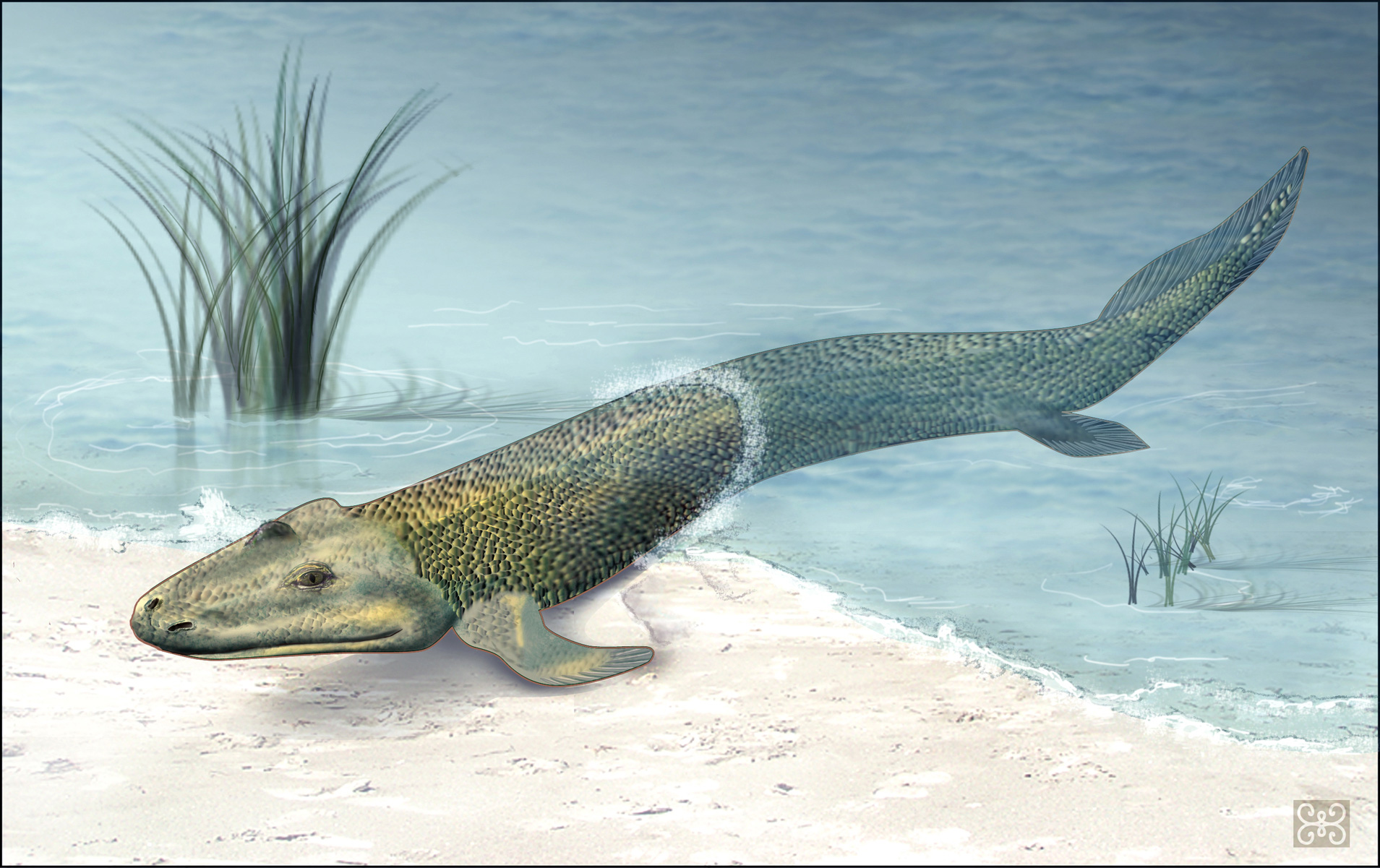
- %%late Devonian%% ==(375 MYA)==
- discovered in %%Canada%% in %%2004%%
- predated %%Ichthyostega%% by %%5 million years%%
- thought to be the oldest up til this point
- %%1-2m%% long
- most notable feature: %%front pair fins with wrist-like structure%%
- other features
- ^^spiracles (primitive nostrils)^^
- ^^lungs & gills^^
- %%1st%% tetrapod with %%proper neck%%
- %%greater flexibility%% during short bouts on land
Ichthyostega (“roof fish”)

- %%late Devonian%% ==(370 MYA)==
- discovered in %%Greenland%%
- 5 ft, 50 lbs
- fish & amphibian features
- %%webbed feet%%
- could %%breathe air%% for %%short%% periods of time
Eryops

- %%Permian (270 MYA)%%
- %%crocodile-like%% early amphibian
- %%aquatic%% & %%terrestrial%%
- had some structural %%features%% that would %%appear%% in %%later%% reptiles
Diplocaulus (“double stalk”)
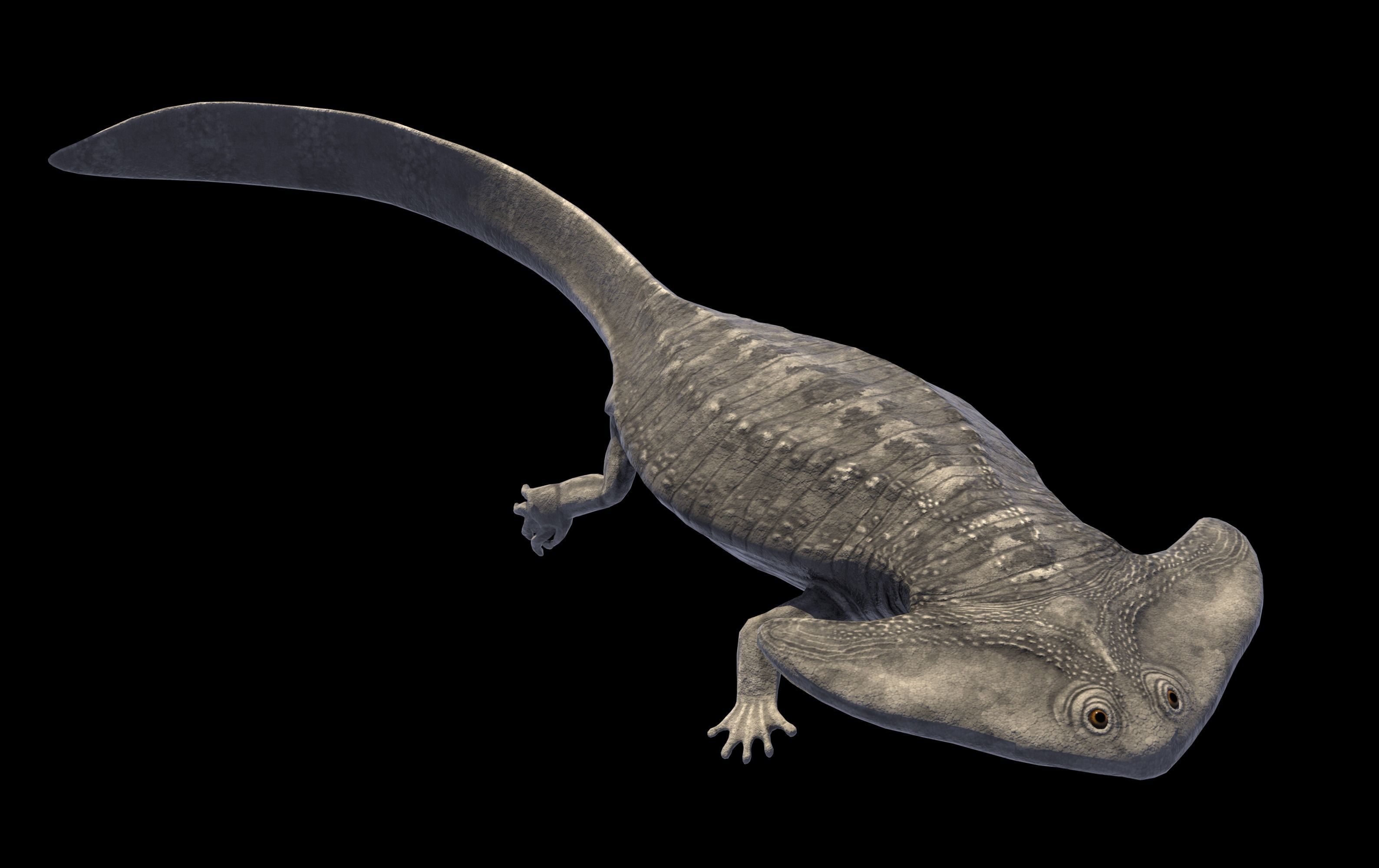
- %%middle-late Permian (240-230 MYA)%%
- 3ft, 5-10 lbs
- %%wide V-shaped boomerang head%%
- possibly used to %%navigate strong currents%%
- facilitated rapid opening for %%suction-gape feeding%%
Frog Evolution Trends
- several modifications for jumping
- vertebral column %%short%% & %%inflexible%%
- reduction in ^^presacral vertebrae^^
- found within pelvis (cervical, thoracic, lumbar)
- increase ^^rigidity^^, ^^absorption^^ of landing
- transfer ^^energy^^ directly to ^^hind limbs^^
- ^^enlarged^^ pelvic girdle, ^^strengthened^^ & ^^anchored^^ to vertebral column
- ^^no ribs^^
- ^^no tail as adult^^
- overall body ^^truncated^^
- hind limbs ^^elongated^^ for jumping
- ^^muscles^^ modified for jumping
Amphibamus (“equal legs”)

- %%late Carboniferous (300 MYA)%%
- swamps in %%Europe%% & %%NA%%
- 6 inches, few ounces
- more %%salamander-like%% than frog-like
- %%33 presacral vertebrae%%
- common characteristic of early amphibs (%%large amount%% of presacral vertebrae)
Gerobatrachus (“frogmander”)
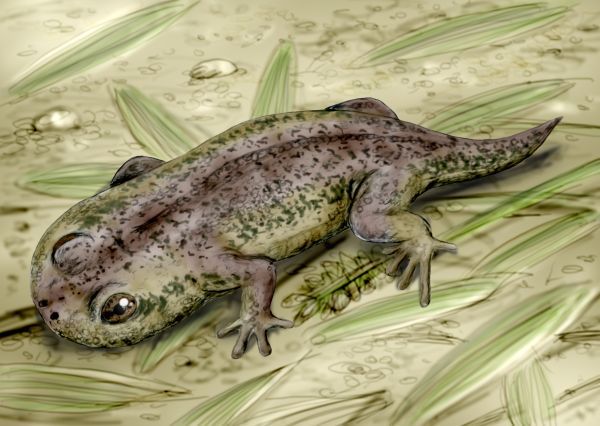
- %%early Permian (290 MYA)%%
- found in %%Texas%% in %%2008%%
- why is it called “%%frogmander%%?”
- ^^2 fused ankle bones^^
- ^^backbone intermediate in length^^
- decrease from 33 vertebrae in Amphibamus
- ^^large tympanum (large, external ear on frogs)^^
- ^^wide, frog-like skull^^
- likely %%transitional%%
- ==240-275 MYA splitting frogs & salamanders==
Triadobatrachus (“proto frog”)
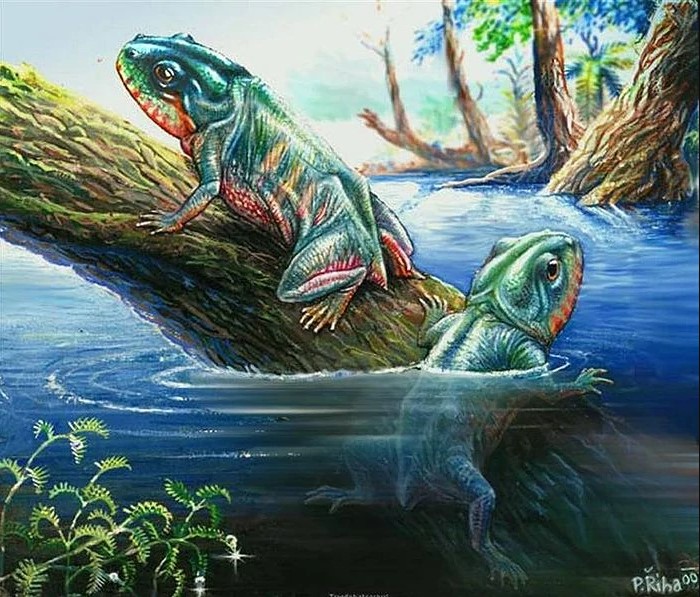
- %%early Triassic (250 MYA)%%
- found in %%Madagascar%%
- ==first fossil frog==
- characteristics
- ^^short, stubby tails^^
- ^^10 cm^^
- ^^13-14 presacral vertebrae^^
- ^^9 in modern frogs^^
Viraella
- %%early Jurassic (~200 MYA)%%
- found in %%Argentina%%
- ==earliest “true” frog==
- may belong to %%Leiopelmatidae%% (modern family)
- %%classic%% frog-like head & large eyes
- legs modified for %%jumping%% (explored in next point)
Triadobatrachus vs. Viraella
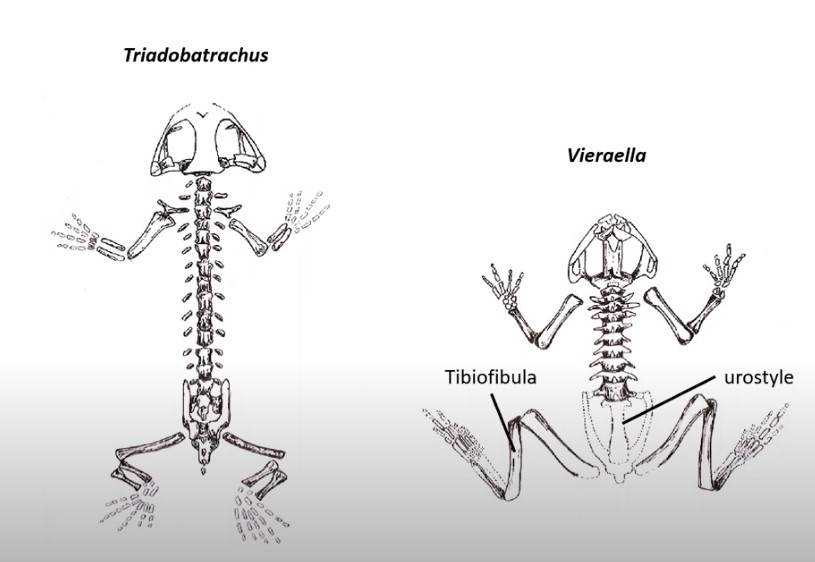
- Vieraella more truncated overall
- %%reduction%% %%in presacral vertebrae%%
- %%enlarged & fused%% pelvic bones in %%Viraella%%
- fused %%tibiofibula%% in %%Viraella%%
Paleobatrachus (“ancient frog”)


- %%Cretaceous--Tertiary (130-135 MYA)%%
- found in %%Europe%%
- %%completely aquatic%%
- inhabited %%swamp basins%%
- %%volcanic gases%% preserved soft %%tissue%%
- resembles present day %%Xenopus%%
Amphibians vs. Reptiles
- amphibians
- clawless
- scaleless
- moist skin (respiration)
- unshelled eggs
- reptiles
- limbs & muscles
- increased brain size (cerebrum & cerebellum)
- more effective jaw
- skeletal structure improved
- skin toughened with scales
- reduced cutaneous respiration
- well-developed lungs
- consequence of scales
- amniote egg
- no longer relied on water for breeding
- arose from anthracosaurs (later tetrapods)
Order Caudata (Salamanders)
- characteristics
- %%smooth%% skin
- %%long tails%%
- long %%cylindrical%% bodies
- most have %%2 pairs%% of very %%well developed limbs%%
- some have %%nasolabial groove%%
- little groove that runs from nose to lips
- %%costal grooves%%
- body folds found on their sides
- %%carniverous & cannibalistic%%
- secretive & nocturnal
- %%greater diversity%% in ^^development, respiration, and reproduction^^ than any other vertebrate group
- %%nearly all%% salamander larvae have external gills
- reabsorbed later
- Sirenidae keeps external gills (paedomorphic)
- habitat & distribution
- common throughout U.S.
- 70% of ~400 spp. of salamander found worldwide are located in Central & NA
- mostly found in %%moist woodland%% habitats
- ^^hardwood & coniferous forests, grasslands, lowland floodplains^^
- highly dependent on ^^precipitation, temperature, & vegetation type^^
- %%Four-toed Salamander%% requires %%sphagnum bogs%%
- %%22 spp. & 2 hybrid forms%% of the %%unisexual complex group%% are found in IN
- some spp (Wester Lesser Siren) spend summers in %%estivation%% by encapsulating themselves in a %%mucous-lined cocoon%%
- some %%permanently aquatic%% ^^(ponds, lakes, & streams)^^
- some %%terrestrial%% ^^(under logs, leaf litter, rocks)^^
- reproduction
- %%ephemeral wetlands%%
- breeding season: %%late winter--early spring%%
- few breed in fall
- courtship practices
- ^^nudging^^
- ^^tail & chin tapping^^
- ^^tail fanning^^
- majority of salamanders have %%internal fertilization%%
- male salamanders deposit sperm packets (%%spermatophore%%) which the females pick up with their %%cloaca%%
- %%eggs%% are fertilized as they %%travel through the oviduct%% and encounter %%spermatophore%%
- majority of salamander spp. are %%oviparous%% (lay unshelled eggs)
- ==all IN salamanders are oviparous==
- some give birth to %%gilled larvae%% (%%larviparous%%)
- others give birth to %%fully transformed young%% (%%pueriparity%%)
- eggs prone to %%desiccation/drying out%%
- must lay eggs either in %%moist soil%% or in %%water%%
- most %%do not provide parental care%%
- many %%do guard eggs%%
- diet
- %%carnivorous%%; mostly ^^insects, spiders, & earthworms^^
- occasional %%cannablism%%
Salamander Family Phylogeny
- %%10%% recognized families
- %%60%% genera
- %%400%% spp.
- %%Sirenidae%% <3 & %%Cryptobranchidae%% most %%primitive%%
- Polytomy
- ^^Proteidae^^
- ^^Amphiumidae^^
- ^^Plethodontidae^^
- ^^Rhyacotritonidae^^
- ==ALL RELATED; UNKNOWN WHICH IS MORE DERIVED OR PRIMITIVE==
- Salamandridae, Dicamptodontidae, & Ambystomatidae
- most %%derived%% (especially %%Ambystomatidae%%)
Sirenidae (“Sirens”) <3
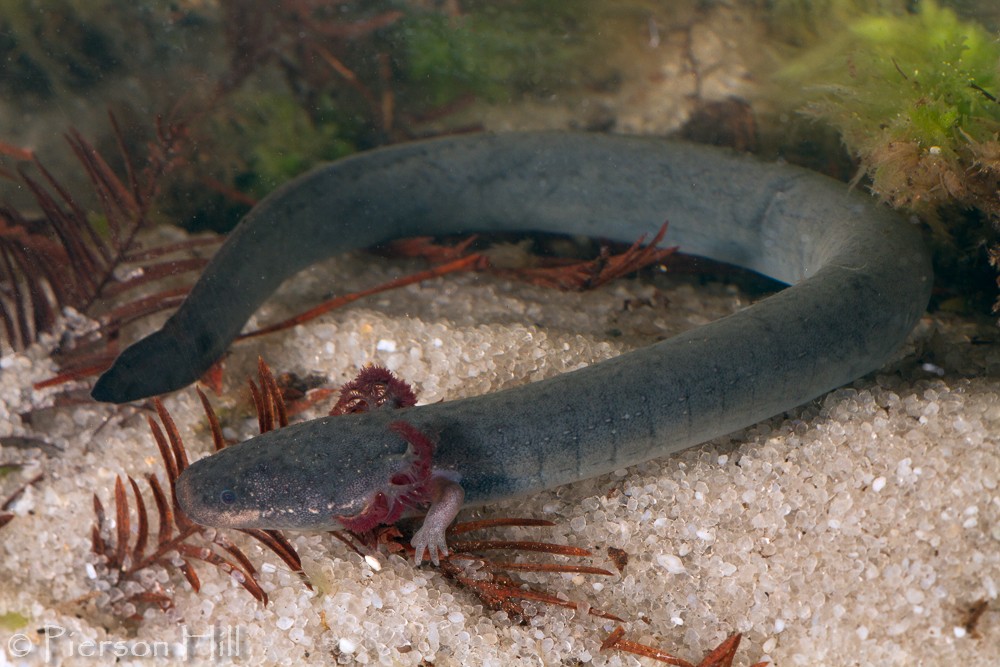
- 100 million years old--oldest extand Salamander families
- 4 spp. & 2 genera
- characteristics
- eel-like bodies & front limbs
- has %%forelimbs%%; ==NO HIND LIMBS==
- %%paedomorphic%%
- retain larval characteristics as adults
- %%external gills%%
- lack ^^eyelids, premaxillary teeth, & hind limbs^^
- nocturnal
- distribution
- fully %%aquatic%%
- heavily %%vegetated%%, %%slow%% moving water
- ^^shallow water, swamps, ditches, ponds, etc.^^
- found primarily in %%southeastern NA%% (not really common in IN)
- reproduction
- breeding season: %%early spring%%
- %%200-700%% eggs deposited to base of %%aquatic vegetation%%
- may have %%external fertilization%%
- %%special concern%%; may eventually become %%endangered%% :(
Cryptobranchidae (“giant salamanders”)

- %%3%% spp. & %%2%% genera
- ^^Eastern Hellbender^^ (%%smallest%%)
- found only in northeastern USA
- ^^Japanese Giant Salamander^^
- ^^Chinese Giant Salamander^^ (%%largest%%)
- 1.5m & ~100 lbs
- characteristics
- %%paedomorphic%%
- %%flattened%% body & head
- %%skin folds%% for respiration
- distribution
- %%fully aquatic%%
- cold, fast moving streams
- %%cool%% %%shallow%% areas where %%rocks not embedded in substrate%%
- essentially nocturnal
- diet
- %%primary: crawfish%%
- fish, aquatic insects
- reproduction
- %%external fertilization%%
- %%multiple females%% may lay eggs in %%one male’s%% nest (which are defended)
- male fertilizes eggs; %%chases away female%%
- eggs hatch in %%~55-75 days%%
- young remain in %%larval stage%% for %%2 years%%
- %%juveniles%% require an additional %%3-4 years%% to reach %%sexual maturity%%
Proteidae (“mudpuppies”)

- %%6%% spp. & %%2%% genera
- characteristics
- similar to %%sirens%%, but have %%hind limbs%%
- large, bushy external gills (%%paedomorphic%%)
- %%caudal fins%%
- %%4 toes%%
- diet
- insects & fish
- distribution
- %%fully aquatic%%
- ^^lakes, ponds, rivers, & streams^^
- rarely seen in depths less than 1 meter
- commonly found %%20 meters below surface%%
- found in %%central & eastern USA, southern Europe%%
- reproduction
- ==internal fertilization==
- males & females guard eggs
- why “mudpuppy?”
- stems from the %%erroneous%% belief that members of this family smit %%barking sounds when disturbed%%
- %%special concern%%; may become %%endangered%%
Ambystomatidae (“mole salamanders”)
%%30%% spp.
characteristics
- stout bodies
- thick, robust limbs
- thick tails
- short, blunt head
- functional %%lungs%%
reproduction
- breeding season: %%spring%%
- males & females %%migrate%% in the hundreds to %%ephemeral ponds%%
- lay %%eggs%% in %%water%%
- stay in %%aquatic salamander larvae%% form for %%4-6 months%%
- %%metamorphose (indirect development)%%
- %%leave%% aquatic environment
- spend life on %%land%%
why “mole salamanders?”
- comes from their habit of %%staying underground & in burrows of other creatures%% except when breeding
\
Plethodontidae (“lungless salamanders”)
- %%2/3 of all salamander spp%%. belong here
- characteristics
- primarily %%breathe%% through %%moist skin%%
- %%thin, elongated%% bodies
- prominent %%coastal grooves%%
- ONLY family with ==nasolabial groove==
- %%autotomize tail when attacked%%
- distribution
- diverse habitats
- fully/semi/not aquatic
- reproduction
- %%internal fertilization%%
- eggs hatch into mini adults ==(direct development)==
- diet
- typically feed %%at night%%
- ^^insects, millipedes, worms, spiders, snails, & mites^^
Salamandridae (“newts”)
characteristics
- thick, %%granular%% skin
- granules due to %%numerous toxic glands%%
- %%aposematic%%
- %%bright coloration%% usually to deter predators
- unken reflex
- %%posturing%% areas laden with %%high toxicity%%
- tetrodotoxin
- %%neurotoxin%% used for chemical defense
distribution
- live in %%forests%%
reproduction
lay %%eggs%% in %%water%%
eggs --> %%gilled larvae%%
partial transformation into %%red efts%% (2-3 years)
- really %%bright%% skin
- %%only terrestrial stage of newt%%
- %%only%% found in this %%family%%
reach sexual maturity and %%spend life in water%%
distribution
- found in eastern & western NA, Europe, Africa, & Asia
diet
- eat invertebrates, amphibian, & fish eggs
Anuran Diversity (Anura = “without tail”)
- currently 45 recognized families
- ~5,500 spp.
- %%constantly changing%% taxonomy
- spp. discoveries
- genetic technologies
- ==FROGS ARE LEAPERS; TOADS ARE HOPPERS==
- found on all continents %%except Antarctica%%
- reproduction
- %%metamorphose%% (indirect development)
- only %%4 spp.%% have tails as adults
- usually %%external fertilization%%
- diet
- tadpole: herbivorous
- adults: carnivorous
Scaphiopodidae (“Nearctic Spadefoot Toads”)
- characteristics
- %%circular/sickle-shaped%% hardened keratinous structure on %%hindfoot%%, forming a %%spade%%
- %%transitional%% spp.; somewhat %%warty and smooth%%
- vertical pupils
- %%don’t%% have prominent %%paratid glands%%
- glands that secrete %%toxic substance%%
- distribution
- found on tropical forest floors
- NA, Europe, Asia, Africa
- reproduction
- breed in %%temporary ponds%%; %%highly accelerated development%%
- diet
- eat many insects
- special concern
Hylidae (“Treefrogs”)
- 800 spp. & 45 genera
- characteristics
- %%smooth & somewhat warty%%
- mostly well %%camouflaged%% (has %%flash colors%% though)
- can have %%large or small toepad%%s depending on habitat
- distribution
- most boreal, some aquatic or fossorial
- NA, SA, Europe, Asia, Australia
- reproduction
- all return to water to breed
- %%external fertilization%%
- diet
- carnivorous insectivores
Bufonidae (“Toads”)
- ~500 spp.
- characteristics
- %%thick, granular, warty%% skin
- %%Bidder’s organ%%
- vestigal ovary on larval testes
- %%prominent parotid gland%% that secretes toxic substance
- %%diurnal%% during %%spring & fall%%; mostly active at night in hot & humid weather
- distribution
- most are terrestrial or fossorial
- reproduction
- all return to water to breed
- external fertilization
Ranidae (“True frogs”)
~300 spp.
characteristics
- %%slim-waisted%% with long legs, %%smooth%% skin, & %%prominent tympanums%%
- %%dorsal lateral skin folds%% on back or around tympanum
- extensive hind feet %%webbing%%
- aquatic & nocturnal
- some fossorial, arboreal, or terrestrial
reproduction
- eggs deposited in shallow pond or creek
- tadpoles
- froglets
- frogs
diet
- tadpoles: herbivorous
- juveniles & adults: insectivorous
- some can eat other frogs, turtles, small mammals/birds, etc.
Phylogeny of Reptiles
- diverged from amphibians in %%Carboniferous%% era, %%Permian%% period (%%arid%% transition)
- %%better fossil record%%
- focus on
- ^^synapsids (archosaurians)^^
- ^^diapsids (archosaurians, lepidosaurs)^^
- ^^anapsids^^
Synapsids (“archosaurians”)
- %%branched early%% on from %%amphibian%% line
- completely %%terrestrial%%
- %%shelled & amniotic egg%%
- modern day %%mammal%%
Diapsids (“archosaurians, lepidosaurs”)
- archosaurs
- gave rise to modern %%birds & crocodilians%%
- largely responsible for %%dinos%%
- lepidosaurs
- modern %%snakes & lizards%% (Jurassic)
Anapsids (“turtles”)
- Triassic
- basic body plan %%(stayed the same for millions of years)%%
- %%Odontochelys%%
- late Triassic %%(220 MYA)%%
- discovered in %%2008%%, predates %%Proganochelys by 10M years%%
- %%“toothed shell”%%
- found in %%E. Asia%%, shallow marine waters near shore
- %%Proganochelys%%
- late Triassic %%(210 MYA)%%
- most well-known
- %%“early turtle”%%
- 3ft, 75 lbs
- possess %%few teeth%%
- %%modern turtles lack teeth entirely%%
- Jurassic
- %%Eileanchelys%%
- late Jurassic %%(165-160 MYA)%%
- found in W. Europe %%(Scotland)%%
- earliest %%pond%% turtle
- discovered in %%2008%%
- Cretaceous
- %%Archelon (marine turtles <3)%%
- late Cretaceous %%(75-65 MYA)%%
- found in oceans of NA
- %%“Ruling Turtle”%%; 12 ft, 2 tons
- large, %%flipper-like%% arms & legs
- closest living relative: %%leatherback%%
Early Reptiles: Amniotes
- Casineria: Early Carbnoiferous %%(340 MYA)%%
- %%salamander-like%% early tetrapod
- %%5 digits with claws%%
- %%1st amniote%%
- amniotes
- eggs survive %%out of water%%
- disperse onto %%drier land%%
1st Lizards, Hylonomus
- Carboniferous %%(315 MYA)%%
- discovered in %%Canada%%
- characteristics
- %%earliest known reptile%%
- among %%first amniotes%%, anapsid
- small, lizard-like %%(8-12 in)%%
- fossil with %%distinct toe & scales%%
- numerous sharp teeth %%(insectivores)%%
==Mesozoic (“Age of Reptiles”)==
- explosive radiation of reptiles
- most %%numerous%% & %%largest%%
- dominant %%terrestrial%% & %%aerial%% animals
- formidable %%marine%% predators
Archosauromorphs
- ==“Ruling Reptiles” of Mesozoic==
- early %%diapsid%% amniotes
- ancestral to ^^crocodilians, birds, & turtles^^
Crocodilians
- surviving archosaurs
- early ancestors %%(Jurassic-mid Cretaceous)%%
- %%Stomato%%suchus
- ~36 ft
- swamps, N. Africa
- %%Sarco%%suchus
- “flesh crocodile”
- ~40 ft
- %%“Super Croc”%%
Lepidosauromorphs
- %%2nd%% major Diapsid lineage
- ancestral to %%squamates%% ^^(lizards, snakes), tuataras^^
- first appeared %%late Permian%%
Tuatara (Sphenodontia)
- living fossils; %%Triassic%%
- extant; New Zealand
- descended from %%beak-headed reptiles (Rhinocephalia)%%
Order Testudines (or Chelonia), Turtles
- %%shells%% helped them persist for %%200 MYS%%
- %%400 spp.%%
- distribution
- aquatic, semi-aquatic, terrestrial
- reproduction
- oviparous %%(all lay eggs)%%
- diet
- %%most%% adults are %%omnivorous%%; some completely herbivorous/carnivorous
- all turles %%lack teeth%%,
- distribution
- %%tropic & temperate%%
Testudines, Chelydridae (“snapping turtles”)
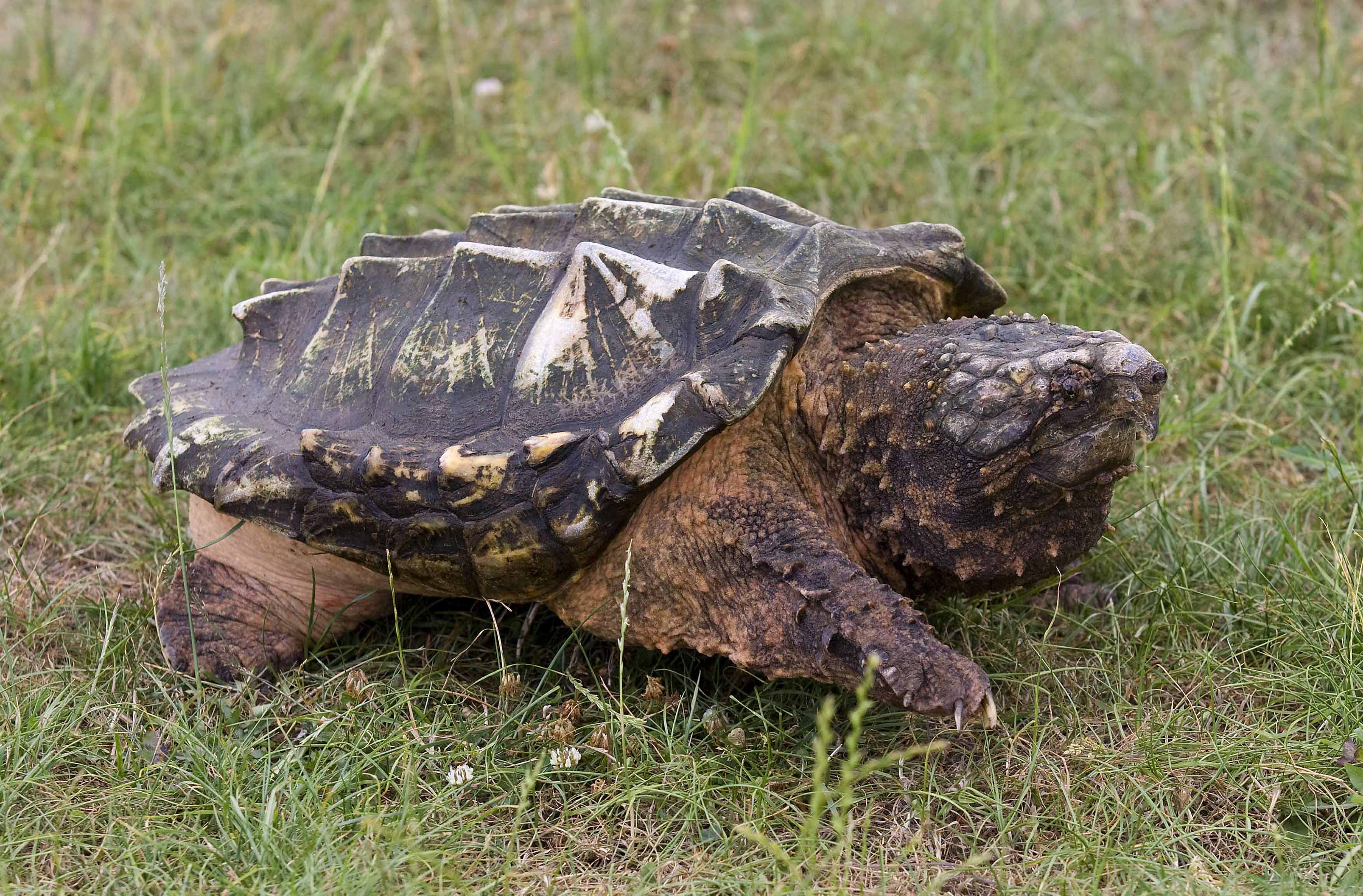
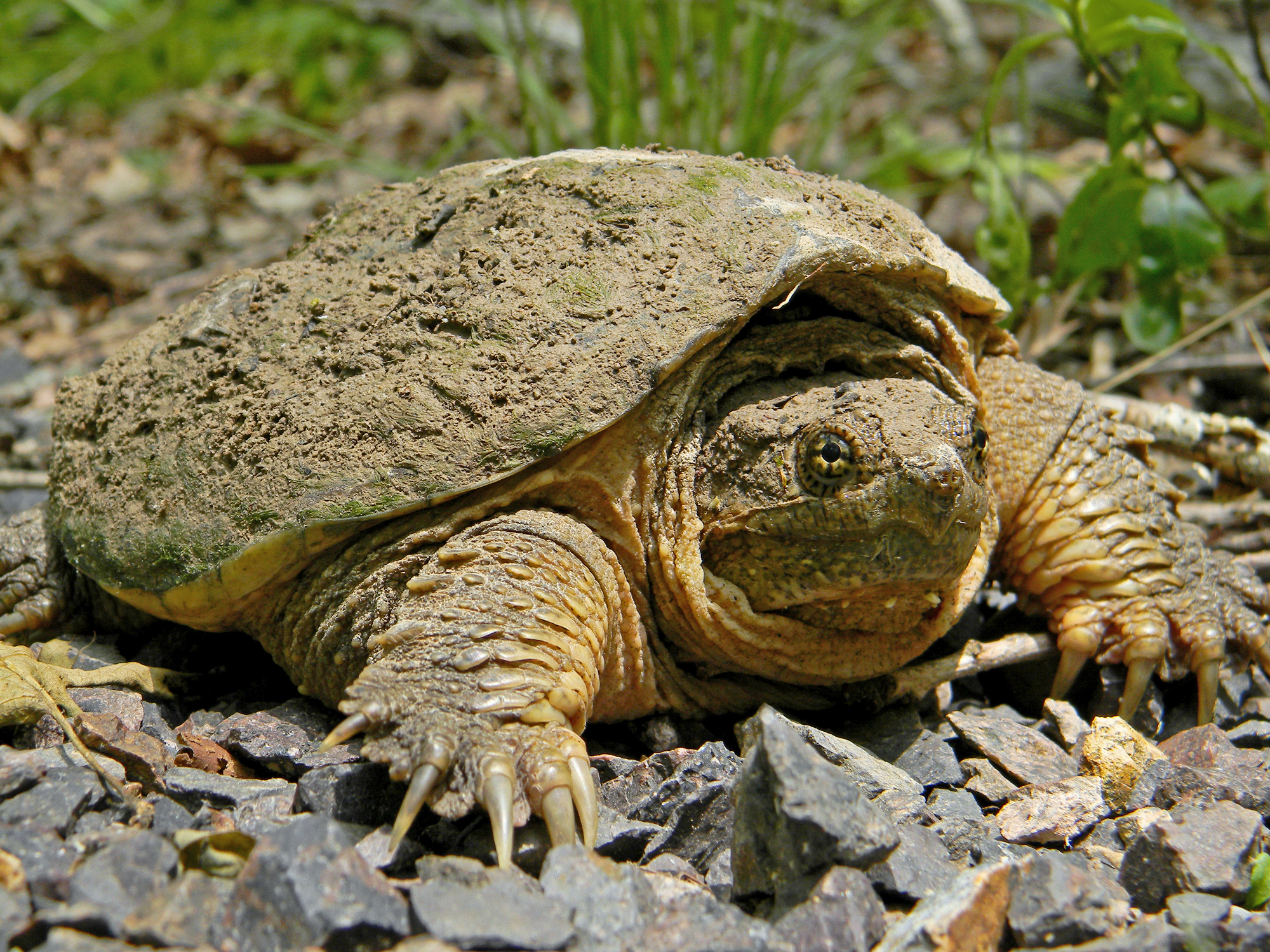
- %%2%% genera; Macroclemys & Chelydra
- each with %%1%% spp.
- characteristics
- large, long tails
- muscular legs
- massive head
- greatly %%reduced plastrons%%
- nocturnal, %%fully aquatic%%
- %%eggs on land%%
- distribution
- NA, SA, SEA
Testudines, Kinosternidae (“mud & musk turtles”)
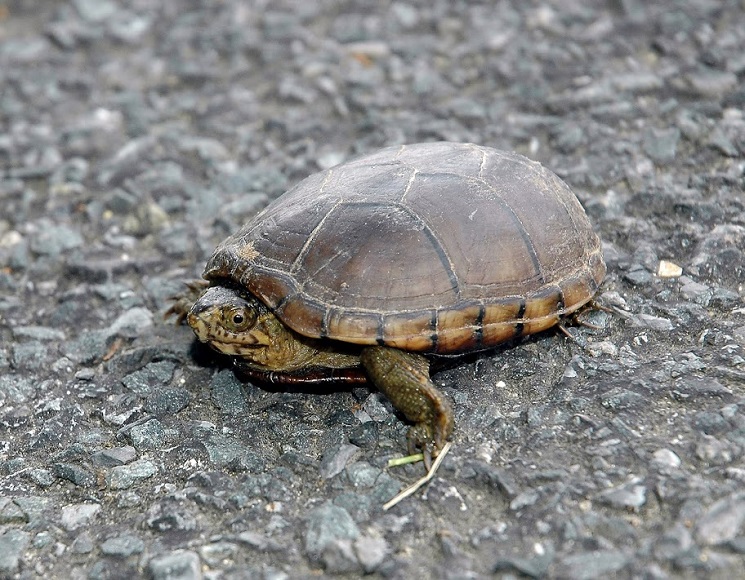
- %%4%% genera, %%23%% spp.
- characteristics
- <6 in
- %%glands%% on side produce %%musky odor%%
- domed carapace & plastron %%(hinged)%%
- distribution
- %%semi-terrestrial%%
- %%poor swimmers%%; walks along bottom of streams & ponds
- prefer %%sandy%% or %%muddy%% dwellings
- reproduction
- lay %%several%% small clutches %%throughout%% year (4-5/clutch)
- ==all but one spp. in IN have TDS (temperature dependent sex)==
- warm = male (depending on spp.)
- diet
- %%omnivorous%%, but prefer ^^insects, tadpoles, & fish^^
Testudines, Emydidae (“basking, marsh, & box turtles”)
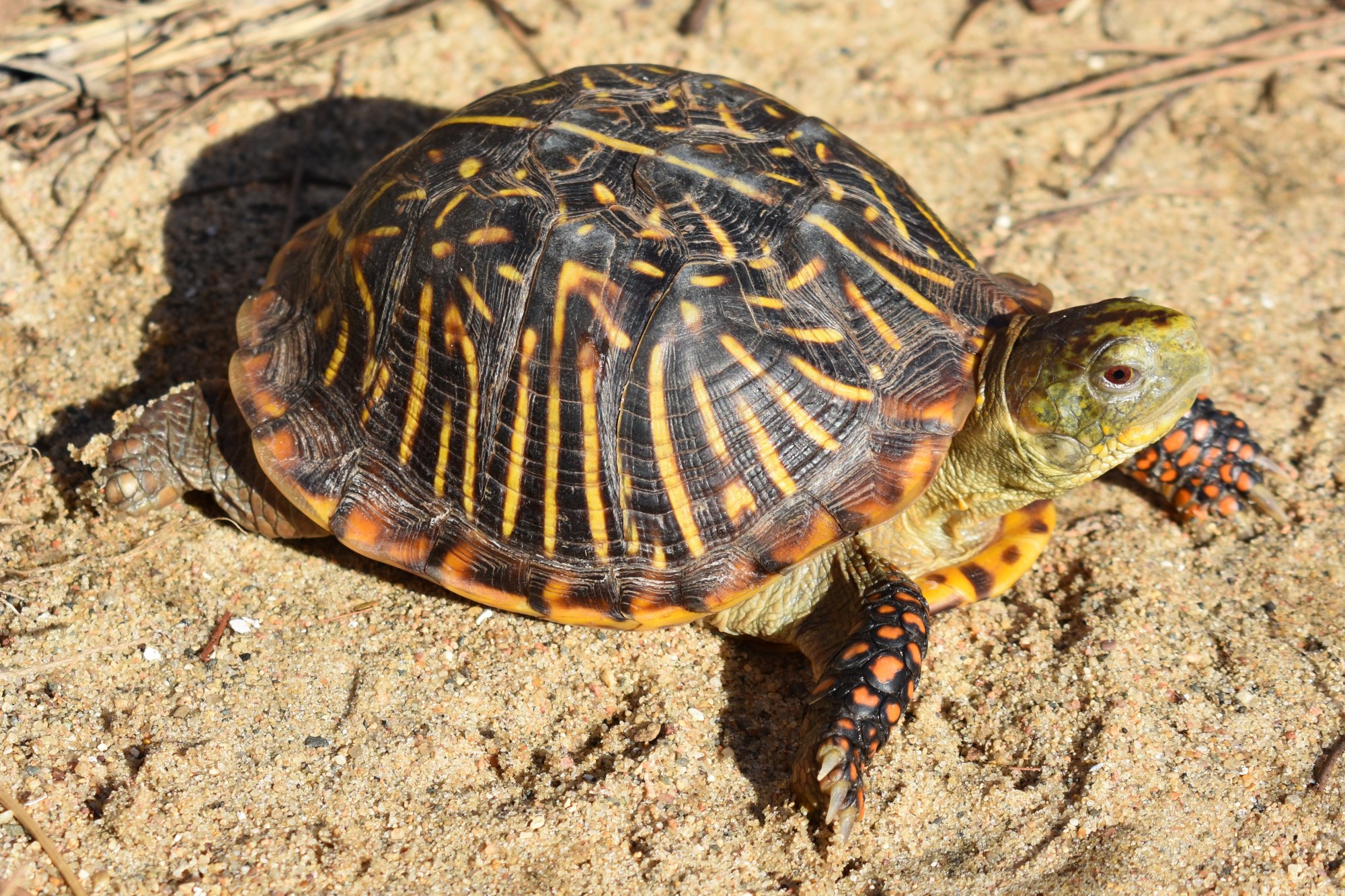
- %%42%% spp.
- %%relatively long-lived%%
- eastern box turtle can live up to %%80-100+ years%%
- distribution
- aquatic, semi-aquatic, some terrestrial
- %%low reproductive rates%%
- countered by %%longevity%%
- diet
- adult: omnivorous; some herbivorous
- juvenlie: carnivorous
Testudines, Trionychidae (“soft-shelled turtles”)
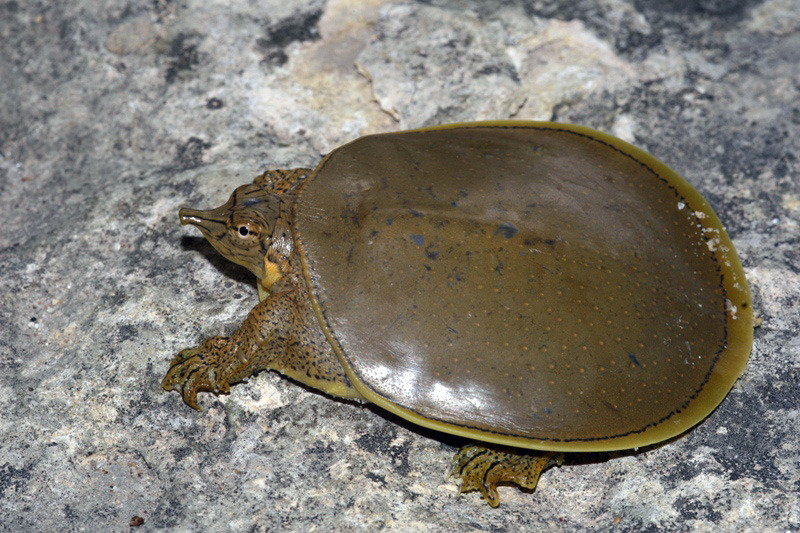
- ==GENETIC SEX DETERMINATION; NOT TSD==
- characteristics
- %%long, tubular nose%%
- fully webbed feet (good swimmers)
- distribution
- almost fully aquatic
- %%pharyngeal respiration%%
- special %%throat lining%% that %%absorbs O2 from water%%
- reproduction
- females lay clutches %%along sand bars/gravel banks%%
Ectothermy: Amphibians & Reptiles
- primary heat source %%external%%
- heat %%not always available%% (winter)
- more %%economical%% (behavioural changes to be warm)
Endothermic: Birds & Mammals
- primary heat source %%internal%%
- better in %%cold environments%%
- more range than ectothermy
- more %%expensive%%
Thermal Interactions & Heat Exchange in Ectotherms
heat exchange with environment occurs via
- ^^radiation^^
- ^^convection^^ (smaller = faster temp change)
- ^^conduction^^ (smaller = faster temp change)
- color also a factor %%(dark absorbs more heat)%%
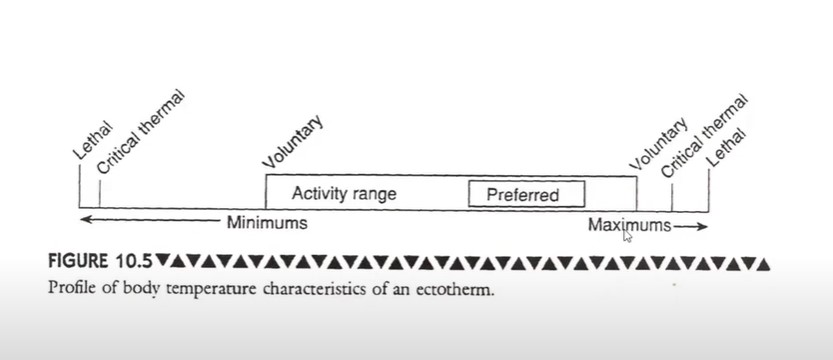
Body Temp Trends
%%max%% & %%min%% voluntary can be %%highly variable%%
%%tropical mean%% temps is %%higher%% than %%temp%%
%%snakes & lizards%% tend to have %%highest body temps%%
warmest to coolest
- lizards
- snakes
- turtles
- frogs
- salamanders
Temp Ranges & Tolerances
- Active Body Temperature %%(ATR)%% varies depending on
- taxa
- habitat
- season
- genetics
- for most, range is between %%27C -- 35C%%
- %%few%% reptiles have ATRs %%<20C%%
Regulation of Body Temps
- due largely to %%behavioural changes%% (change posture/position, etc.)
- amphibians (terrestrial) handle regulation differently because of %%moist skin%%
- %%low resistance to water loss%%
- Tb %%(body temp)%% largely tracks Te %%(environment temp)%%
- couple of degrees %%cooler due to evaporation%%
- %%reptiles%% can be exposed to sun %%without excessive water loss (scales)%%
Dormancy
response to %%temp extremes & environmental cues%%
can occur in %%3 different forms%%
- hibernation
- freeze tolerance
- estivation
Scaphiopus: active 1 month/year in Arizona
Thamnophis: active 4 months/year in Manitoba
dormancy forms explained
hibernation
- %%Tb%% largely allowed to track %%Te%%, except that %%metabolic activities slowed%% even more than “normal” for a given temp
- %%animals tend to move%% during hibernation (brumation)
- %%aquatic%% hibernators %%sink to bottom%%
freezing tolerance
%%ice%% crystals %%destroy%% cells & %%extracellular fluid freezes%% & %%dehydrates%% cells
%%few%% spp. can do this (Pseudacris crucifer <3)
use %%cryoprotectants (glycerol or glucose)%%; replace water in cells with antifreeze
estivation
- animals inhabiting %%desert & semidesert%% environments
- %%physiology not well-known%%
- animals flee to %%deep burrows%% with %%high humidity & moist soils%% & %%reduce their metabolisms%%
- \
eastern spadefoot, Scaphiopodidae
Order Squamata (“Lizards”) [snakes will start later]
- %%8,000%% spp.; %%5,000%% are %%lizard spp.%%
- most %%abundant & diverse%% reptilian group that exists today
- lizards will %%autotomize%% (lose) tails as defense mechanism
- reproduction
- extremely diverse, but all have %%internal fertilization%%
- some %%oviparous%% (lay eggs outside of body)
- some %%viviparous%% (live birth)
- some %%ovoviparous%% (eggs hatched within body)
- some have significant courtships (lizards)
- lay %%flexible%% or %%hard%% eggs
- %%little parental care%%
- diet
- carnivorous
- distribution
- occur in all %%tropical & temperate%% regions
Phrynosomatidae (“spiny lizards”)
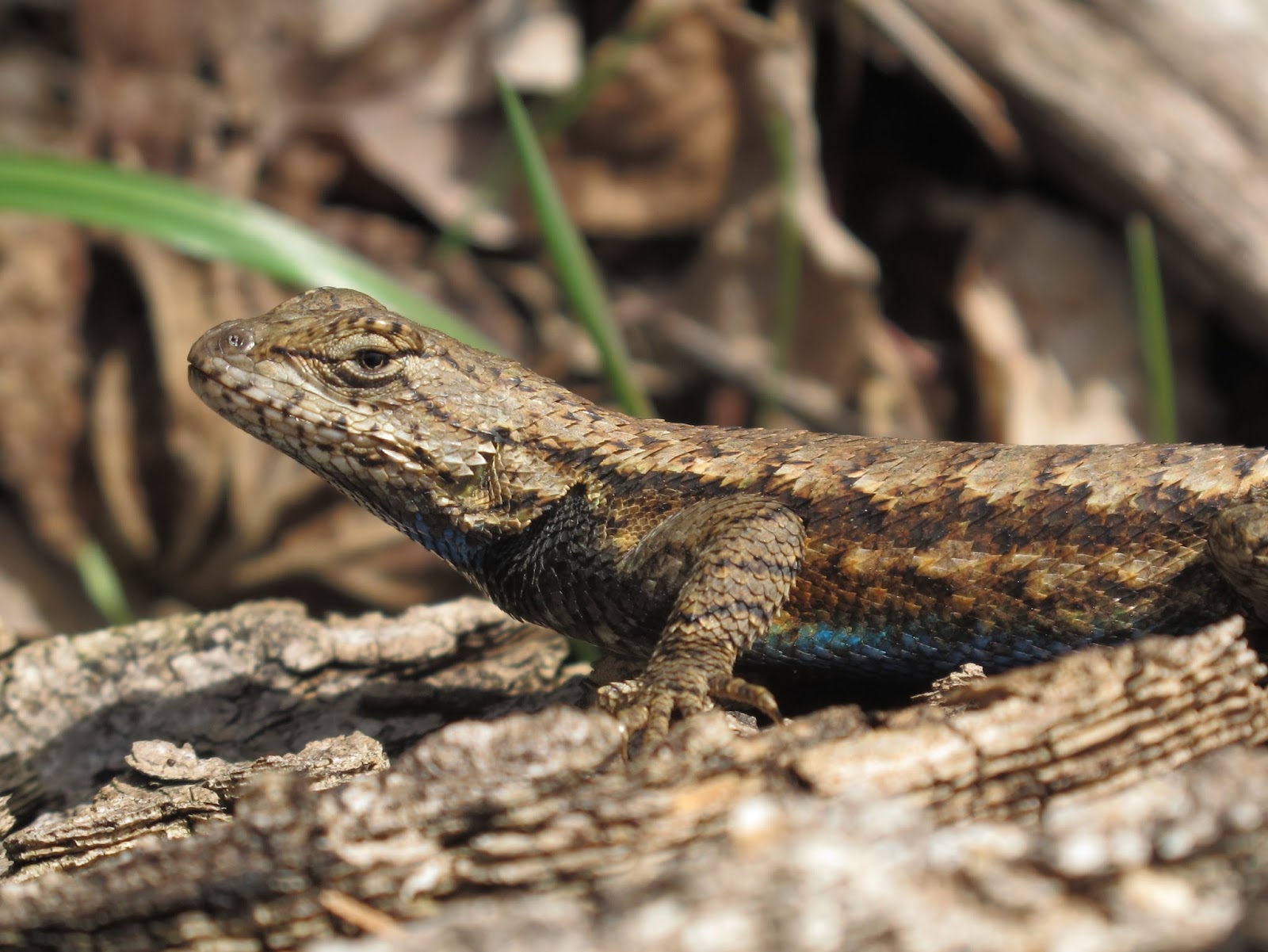
- %%125%% spp.
- %%many morphological differences%%
- distribution
- Sceloporus: arboreal, terrestrial, rock-dwelling
- reproduction
- most %%oviparous%%
- some %%viviparous%%
Anguidae (“glass or alligator lizards”) ==LEGLESS==
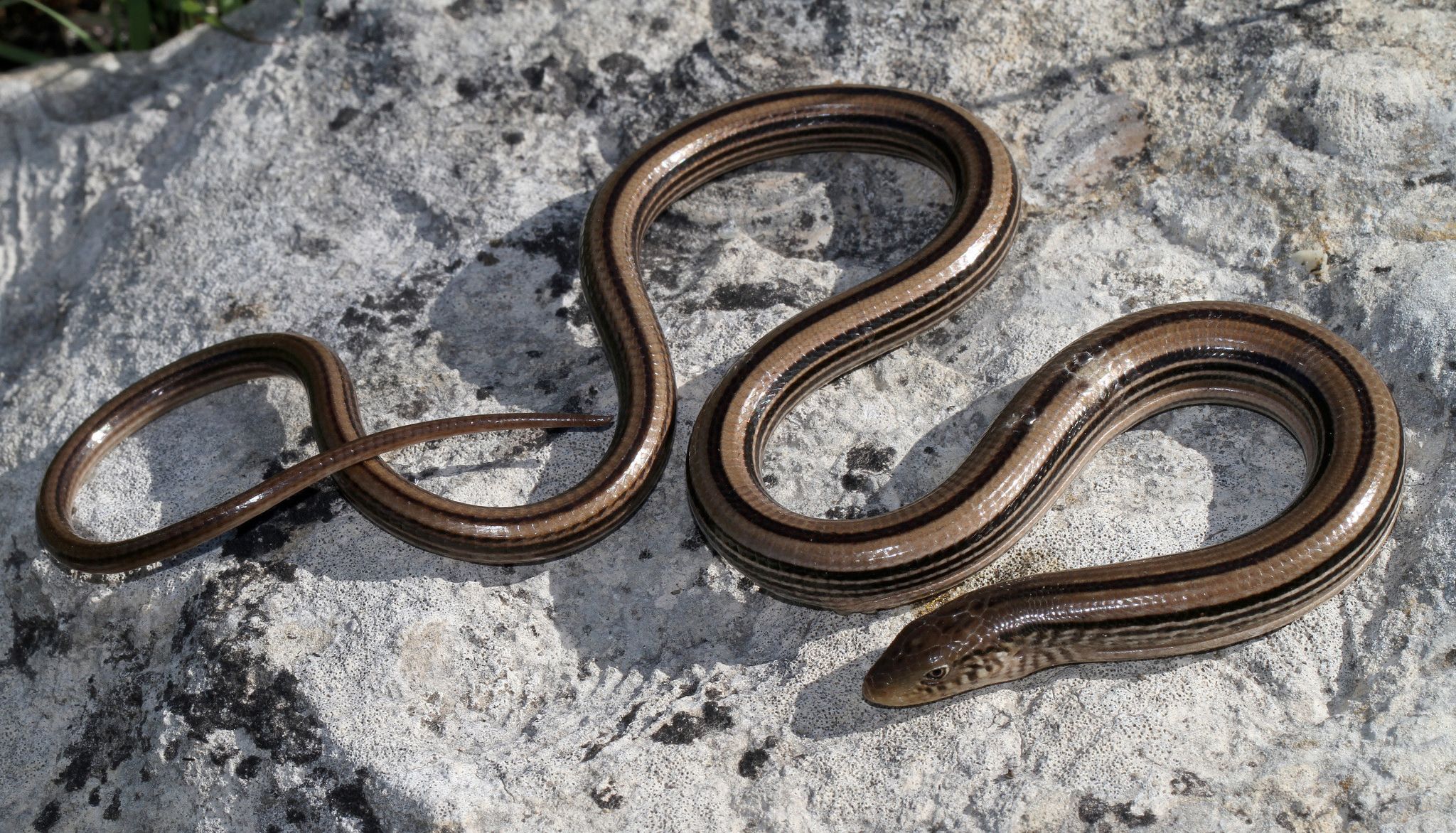
- %%120%% spp.
- characteristics
- has all characteristics of lizard %%(moveable eyelids, external ear)%%
- long & have shiny scales underlined with %%bony plates (osteoderms)%%
- %%autotomize%% their tails (which are %%~2/3--3/4 of whole body%%)
- highly %%terrestrial%% & %%semi-fossorial%%
- reproduction
- mostly %%oviparous%%
- some %%ovoviviparous%%
- few %%viviparous%%
- diet
- carniverous
- distribution
- NA, SA, Europe, Asia
Teridae (“whiptails & racerunners”)
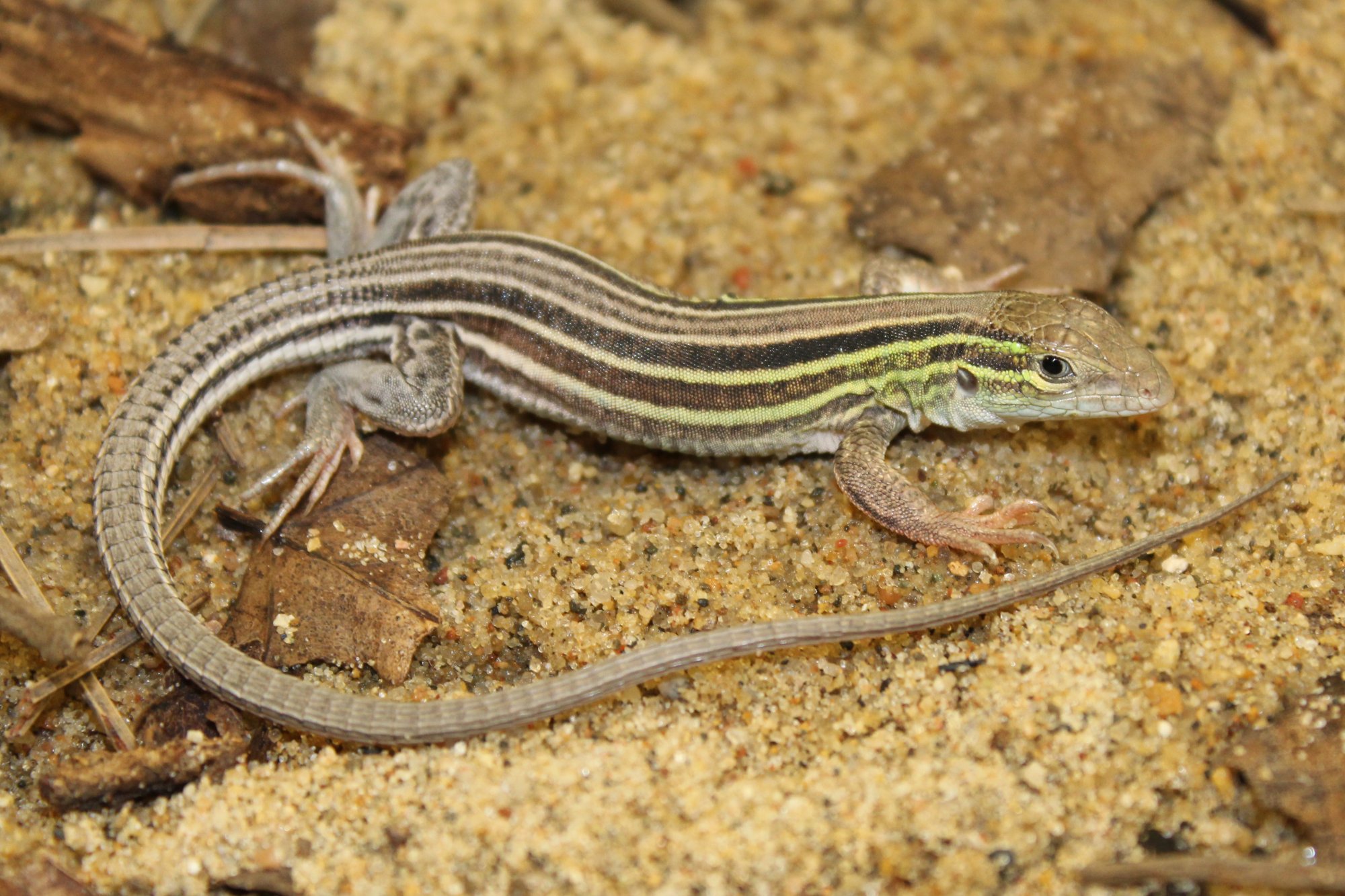
- %%110%% spp
- characteristics
- %%long, slender%% bodies with well-developed %%limbs%% & very long tail
- often have %%yellow stripes%% on body
- males have %%blue/green chest%% during %%breeding%%
- distribution
- only found in NA & SA
- terrestrial; %%sandy prairie%%
- reproduction
- %%oviparous%%
- some spp. are %%parthenogenic%%
- populations are %%all female%%, so all eggs laid are %%unfertilized & clones of the mother%%
- six-lined racerunner is ==NOT PARTHENOGENIC==
Scincidae (“skinks”)
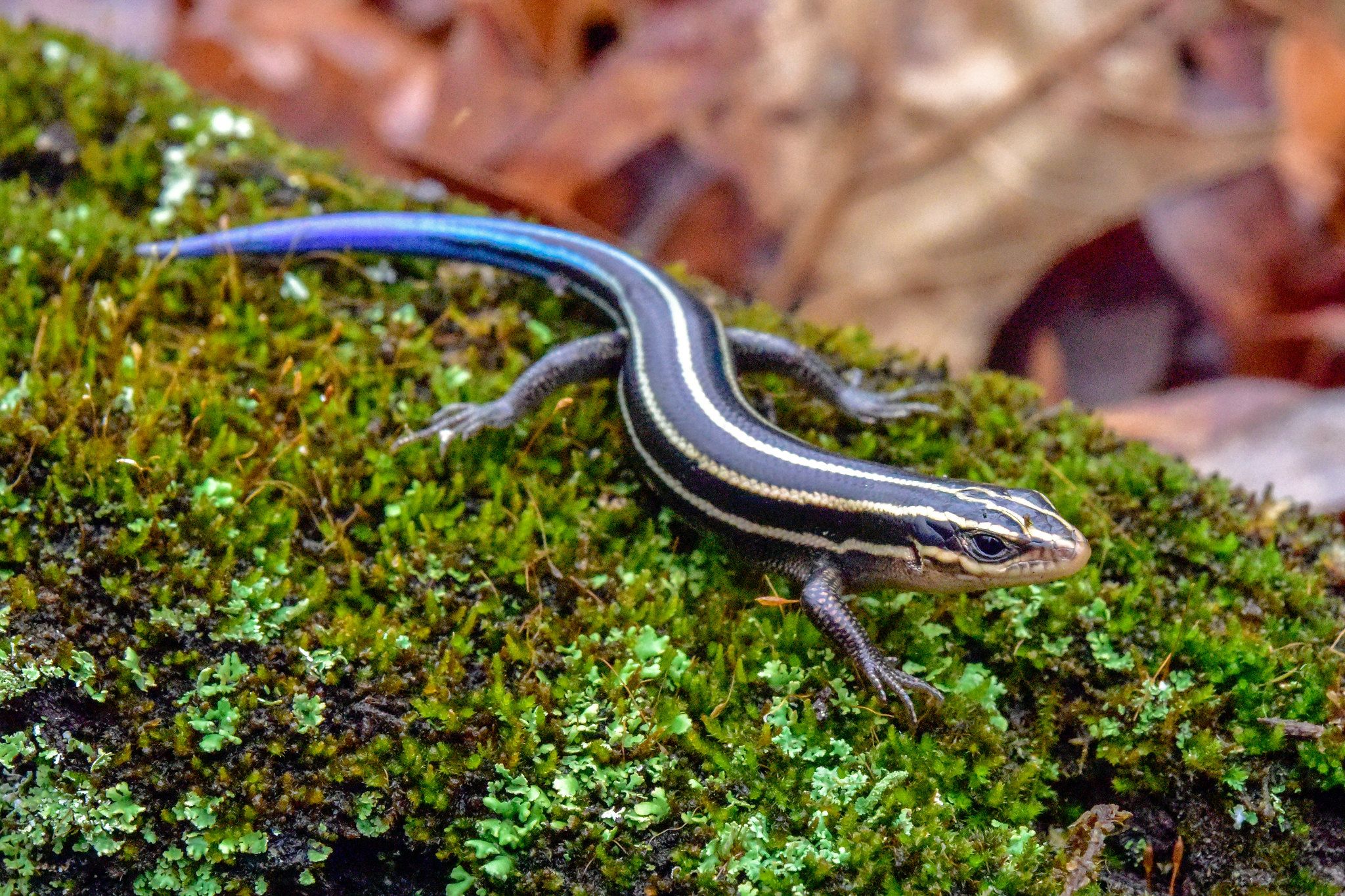
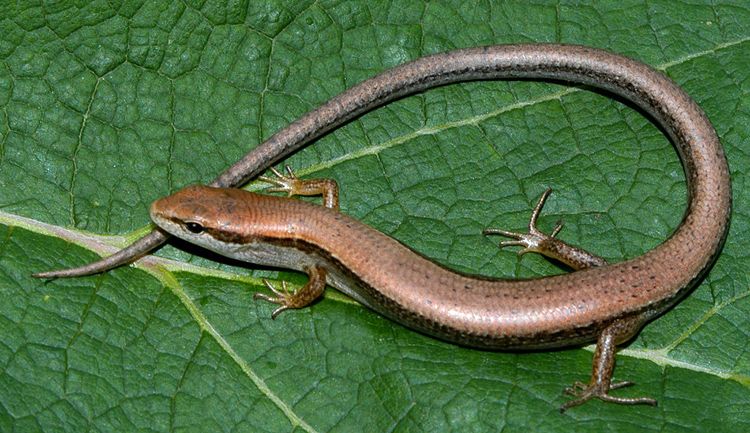
- %%largest of all lizard families (1200 spp.)%%
- characteristics
- %%osteoderms%% give them stiff & shiny bodies
- %%autotomize%% tails
- distribution
- %%highly varied%%
- ^^terrestrial, semi-fossorial, diurnal, etc.^^
- everywhere except Antarctica
- reproduction
- ^^oviparous, ovoviviparous, viviparous^^
- diet
- insectivorous
Order Squamata (“snakes”)
- %%3000%% spp.
- characteristics
- %%immovable%% eyelids
- legless
- no external ears
- %%Jacobson’s organ%% (tongue-flicking)
- left lung either %%entirely absent or highly degenerate%%
- distribution
- highly varied habitats ^^(terrestrial, arboreal, etc.)^^
- reproduction
- mostly %%oviparous%%, but can be other two
Viperidae (“vipers”)
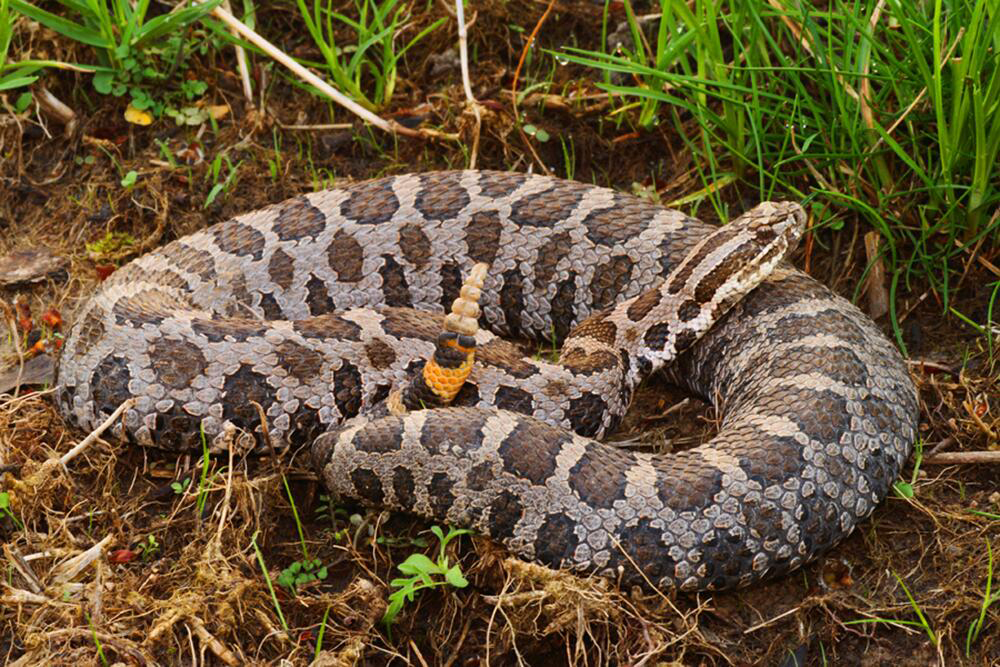
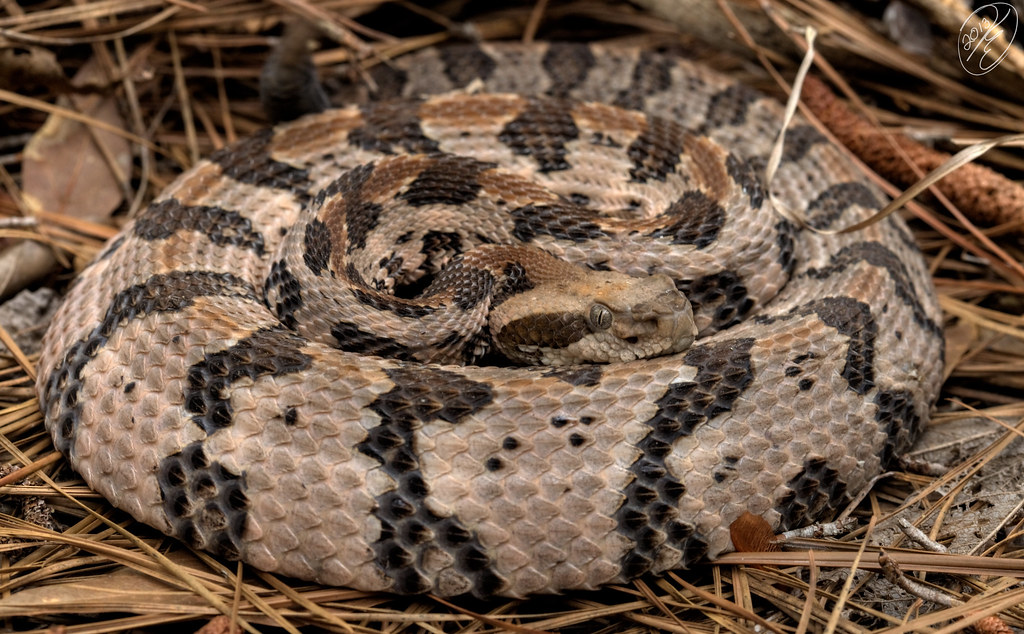
- %%215%% spp.
- characteristics
- long %%hinged fangs%% with a %%hemotoxin%% (swelling & hemorraging)
- cobras have a %%neurotoxin%% (central nervous system)
- %%broad%% heads & %%stocky%% bodies
- %%Loreal pit organ senses heat%%
- habitat
- terrestrial with wide variety of habitats
- NA, SA, Europe, Africa, Asia
- reproduction
- viviparous
- diet
- carniverous
Colubridae (“snakes”)
- was 2000, but now %%650%% spp.
- characteristics
- can be 7in -- 12ft
- distribution
- terrestrial & aquatic
- reproduction
- oviparous
- ovoviviparous
Natricidae (“snakes”)
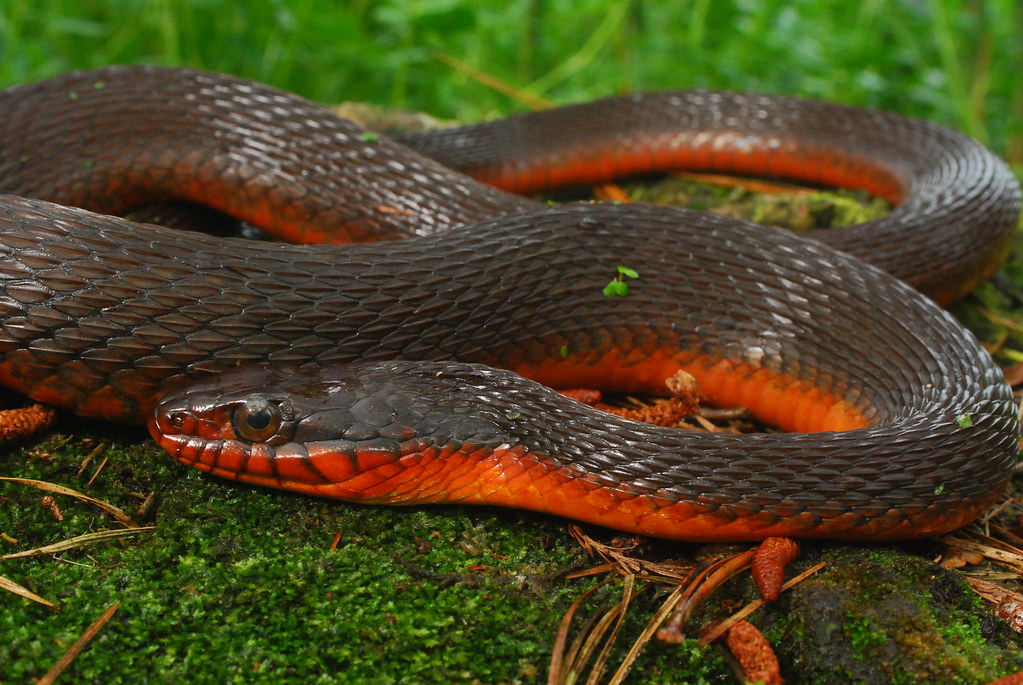

- %%200%% spp.
- distribution
- mostly tied to aquatic environments
- reproduction
- viviparous
- ovoviviparous
- diet
- carnivorous
Dipsadidae (“snakes”)
- %%700%% spp.
- characteristics
- small-medium
- from New World
- distribution
- %%secretive%%; hides under cover
- reproduction
- oviparous
- diet
- diverse ^^(invertebrates, amphibians, etc.)^^
Reproduction & Life Histories
- fertilization can happen %%inside/outside of female%%
- development can be %%direct/indirect%%
Gametogenesis & Ovulation
- most amphibians, 2 sexes required
- reproductive %%timing%% has %%internal%% controls
- ultimately coordinated by %%environment%% (temp & photoperiod change)
- Gametogensis
- %%division & growth of gametes%% within %%ovaries & testes%% through %%hormonal activation%%
- Vitellogensis
- %%accumulation of nutrients%% in cytoplasm of developing egg
- rapid growth of oocytes (egg 10-100x size)
- Ovulation
- occurs when %%follicular%% & %%ovarian walls%% rupture
- releases ova into oviduct
- as eggs pass through oviduct, %%protective membrane%% are deposited around them
- %%number of layers is spp. specific%%
- %%amphibian%% eggs are %%anamniotic%%
- eggs expelled in %%gelatinous masses or strings%%
Fertilization
%%penetration of sperm & fusion of male & female pronuclei%%
%%many%% sperm can reach the egg, but %%only one%% will penetrate it
- %%salamanders%% have %%polyspermic fertilization%%
- sperm heads %%(acrosomes)%% %%digest%% eggs membranes, making %%tiny hole%%
- sperm pronuclei %%moves into ova cytoplasm; fusion%%
2 types
external
- normal for %%Sirenidae & Cryptobranchidae, and most Anurans%%
internal
- found in %%other salamander families%%
external
- %%simultaneous shedding of eggs & sperm into water%%
- constrain where eggs are laid
- %%frogs%%: males grasp female in amplexus so their %%cloacas align%%
- %%salamanders%%: either amplexus or %%male follows female%% to deposit
- %%inguinal amplexus%%
- male has %%front legs%% around female’s %%upper waist%% (under arms)
- %%cephalic amplexus%%
- male’s %%hind legs%% wraps around %%female’s head%%
internal
- few frog spp. (Pacific NW), Salamandroidea salamanders, all caecilians
- allows eggs to be laid in %%spot & time of choice%%
- %%frogs%%: %%hemipenis%% delivers sperm to %%female cloaca%%
- %%salamander: spermatophores%% deposited %%externally%%
- proteinaceous pedicel capped by sperm packet
- %%spermatheca%%
- %%sperm storage%% in series of tubules on %%cloaca’s roof%%
Reproduction without Fertilization
asexual reproduction
- %%without male%% contributions
- %%100% female populations in some taxa%%
- 2 types
Hybridogenesis: progeny only %%transmits female chromosome; all female populations%%
Gynogenesis: diploid/triploid egg only %%activated by sperm; no male chromosomes incorproated into embry%%
only female offspring
fathers from 5 specific spp.
- ^^Jefferson salamander, blue spotted salamander, tiger salamander, smallmouth salamander, streamside salamander^^
Gynogenesis
- “unisexual” hybrid Ambystoma complex
- %%5 MYA%%
- ploidy # varies
- %%17 different combos%%
- e.g. 2n, 3n, 4n, 5n (n = copies of genetic contribution)
- if 4n with 4 blue spotted salamander & 1 Jefferson, will look more like blue spotted
Parental Care
any form of %%post-egg laying parental behaviour%% that increases %%offspring survival%% at some %%expense of parent%%
most %%amphibs show no parental care%% aside from %%nest construction%%
represented by a variety of behaviours
- nest, egg, or young attendance/guarding
- egg brooding
- egg, larval, or hatchling transport
- feeding of young
Development
Exotrophic
- %%limited%% amount of %%yolk%%; allows females to lay %%more, but smaller eggs%% (quantity > quality)
- larvae %%hatch quickly%%, but must %%feed themselves%%
Metamorphosis
- %%shift%% from %%embryonic & larval stage%% to mature %%terrestrial stage%%
- initiated %%hormonally%%, but %%environment%% also plays a role ^^(crowding, predation, food availability, etc.)^^
Paedomorphosis
- retention of %%juvenile characteristics as adults%%
- two types
- progenesis: %%accelerated sexual maturity%% relative to %%stomatic growth%%
- neoteny: %%slowing of stomatic growth%% with %%onset%% to %%sexual maturity%%
Growth
%%addition%% of enw tissue %%in excess%% oif what was lost in damaged tissue
two types
embryonic
- increase when %%high quality food%% is in %%abundance%%
- influenced by temp (higher = faster development; not too extreme though)
juvenile
- %%much slower%% because of unpredictable food & environment
==GROWTH IN AMPHIBIANS IS INDETERMINATE/NEVER-ENDING==
Age
intervals ==(periodicity & not age)== are important
- sexual maturity (4 months -- 7 years)
- Embryogenesis (can be %%truncated%% in %%Scaphiopodidae%%)
- larval period → metamorphosis
Dynamics of Reptilian Reproduction
- multitude of %%patterns%% geared to the %%right environment%% for %%offspring%%
- %%all temperate%% spp. are %%cyclic%%
- %%tropical%% spp. %%cyclic%% or %%acyclic%%
- 2 patterns (temperate salamanders)
- %%winter/spring%% mating & egg disposition (Ambystomatids)
- %%late summer/fall%% mating & spring egg disposition (Plethodontids)
- mate attraction & selection
- %%location%% usually %%not%% a problem
- reproduction more %%efficient%% within %%home range%% (sometimes movement is necessary)
- %%courtship%% is key
- female-heavy investment in gametes = %%most fit mate%%
Reproduction & Life Histories of Reptiles
- major difference in reptilian reproduction compared to amphibians
- all have %%internal fertilization%%
- %%direct%% development
- %%amniotic egg%%
- development can occur on %%much drier land%%
Gametogenesis & Ovulation
- Vitellogenesis very important in egg-laying vertebrates
- accumulation of nutrients → yolk
- %%vitellogenin%% selectively absorbed by %%oocytes%% & enzymatically converted to %%yolk proteins%% %%(pinocytosis)%%
Cleidoic (shelled) egg
%%prevents desiccation%% & contamination by %%environmental pathogens%%
creates own %%aquatic environment%%
by %%folding & curling%%, reptile embryo can be %%very long%%
3 extraembryonic membranes are formed (no need to know function)
- Allantois
- Chorion
- Amnion
Fertilization & Copulation
- copulatory organs
- turtle & crocodilians: a penis of %%spongy connective tissue%% erects & retracts via vascular pressure (similar to mammals)
- tuataras don’t have copulatory organs
- squamates: %%penis lost%% & later replaced by %%hemipenis%%
- sperm storage
- %%delayed fertilization%% → females can %%mate with more than one%% male → %%multiple progeny%%
- sperm storage tubules on %%upper-mid%% section of %%oviducts%%
- mechanism for %%expelling sperm%% from these tubules is %%unknown%%
Reproduction without Fertilization (reptiles)
Asexual
- 1 type in reptiles
parthenogenesis
- females reproduce without sperm
- inheritance is clonal
Parental Care
pre-depositional
- involves %%quantity & size of egg components%% (egg components = eggshell, protein, lipids, yolk [oviparous reptiles])
- hatchling turtles & crocodilians have %%50-70% more lipids than required%%
post-depositional
- selection of best sites
live-bearing
20% of all lizards & snakes
ovoviviparous
- holds eggs %%much longer%% than %%oviparous%% spp.
- embryos can be supported %%entirely%% by %%egg yolk%%
- embryos can absorb %%some nutrients%% through %%oviducts%%
viviparous
- %%placenta-like%% structure transfers %%nutrients to developing embryo%%
Embryo Development
- %%direct%% development in %%all%% reptiles
- %%clutch & egg size%% msy be %%proportional to body size%%
- larger female = larger eggs & clutch
- reptilians that develop from terrestrial egg
- humidity (more important for leather eggs)
- temperature (ATR)
- temperature-dependent sex determination %%(TSD)%%
- %%widespread%% in reptiles
- found in ^^all crocodilians, tuataras, & 11 spp. of turtles & squamates^^
- %%average%% temp during %%2nd trimester%%
- crocs & lizards: male at high temps
- turtles: females at high temps
Growth
2 growth pulses
embryonic
- %%increases%% when %%yolk%% is available & %%decreases%% with %%lower Te%%
juvenile
- %%much slower due to unpredictable food & environment%%
Age
- similar to amphibians ==(periodicity > age)==
- conception → hatcling/birth
- sexual maturity
- reproductive senility
- %%reproductive periodicity%% very important
- %%longevity%% can be great for some reptiles
Dynamics of Reproduction
- mate attraction & selection
- %%most fit male >>>%%
- %%territory more important%% because of reduced need to breed
- courtship:
- %%visual%% signals are important, but also %%tactile%% & %%chemosensory%% receptors involved
Introduction
- each population will %%adapt differently%% and will eventually diverge genetically (%%evolve%%) from other populations
- if divergence continues, %%speciation%% would occur (%%rare%% outcome)
- the rate of gene flow is a function of the %%closeness%% of the populations and the %%dispersal%% tendency of the species
Classification
Species
- Today distinguishes by differences in:
- @@body function@@
- @@biochemistry@@
- @@behaviour@@
- @@genetic makeup@@
- ^^Classical Biological Concept Definition:^^
- ^^genetically distinctive^^ populations of individuals ^^isolated reproductively^^ from all other populations
Alternative species concepts
- 27-30 concepts
- Ecological species
- defined in terms of its ^^ecological niche^^
- Morphological species
- defined by ^^morphology^^ (structure)
- Genealogical species
- defined as a ^^set of organisms^^ with a ^^common and unique genetic history^^ as shown by ^^molecular patterns^^
Subspecies
- Def 1:
- ^^Taxonomic subdivision^^ of a species
- Def 2:
- A ^^population^^ of a particular region ^^genetically distinguishable^^ from other populations and capable of ^^interbreeding^^ with them
- Def 3:
- A ^^grouping of organisms^^ that differ from other members of their species by ^^color, size, or various morphological features^^
Cline
A ^^gradual and continual change^^ in a character by a ^^series of populations^^ or ^^throughout the range of a species^^
Usually along a %%geographic or environmental gradient%%
- Individuals at the two extremes differ
Clinal Variation
- \
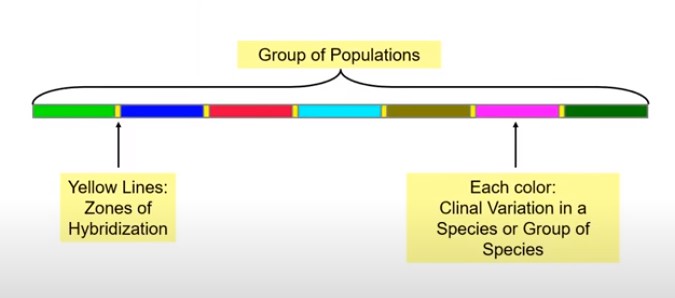
- \
Clinal Variation in plastral markings of painted turtles
Western forms -- intricate
\
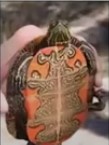
Hybrid -- intermediate
\
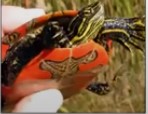
Midwestern/Midland -- single
\
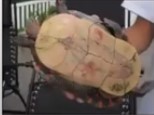
“Ring species”
Individuals that ^^don’t interbreed^^ but all stem from ^^one population^^
\
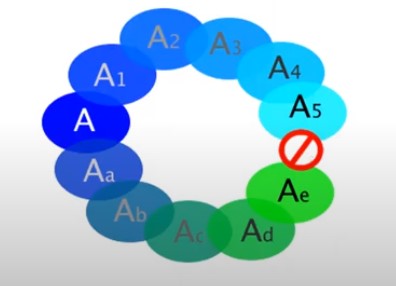
Lungless salamander (Ensatina eschscholtzi)
Morphological Variation
- %%Latitudinal%% changes within a species
- Changes in body weight; %%Bergman’s rule%%
- Animals have a tendency to be %%larger%% in %%polar%% regions, %%medium%% in %%temperate%% climates, and %%smallest%% in %%tropical%% ones
- ==DOES NOT ALWAYS APPLY TO REPTILES & AMPHIBIANS==
- Changes in body %%color%%
Biogeography
%%3 major factors%% influence geographic distributions of amphibians & reptiles
@@Climate@@
Amphibians have 3 factors in regards to climate
@@Temperature@@
@@Rainfall@@
@@Periodicity@@
@@Availability & access to resources@@
@@Dispersal abilities@@
- %%Small fossorial%% amphibians & %%reptiles%% have %%poorer%% dispersal abilities
- %%Large aquatic%% animals tend to be %%better%% dispersers
Movements
Daily Movements
- @@Feeding@@
- @@Thermoregulation@@
- @@Predator avoidance@@
Seasonal Movements
- Generally %%more extensive%% but still generally considered to be %%<0.5 km%%
- @@Breeding@@
- %%Amphibians%% generally go towards %%water%%
- %%Reptiles%% generally go towards %%land%%
- @@Hibernation@@
- Snakes searching for %%hibernacula%% to escape the cold
- @@Habitat Utilization@@
- Largely associated with change in %%food availability%% or %%habitat quality%%
Dispersal
- Movement ^^outward^^ from ^^home area^^; often implies ^^colonization^^
- Important for maintaining %%gene flow%% in a population
- Infers some %%genetic exchange%% (if those dispersing individuals successfully reproduce)
- %%Undirected movement%% to locations %%unknown%% by the dispersing animals
- Costs & benefits
- Benefits
- %%May reduce intra-specific competition%%
- Likely to come into contact with different individuals unrelated to you %%(minimizes inbreeding)%%
- Costs
- %%Resources%% could be lacking
- Increased %%predation%% risk
Orientation & Navigation
- @@Piloting@@
- %%Simplest%% form; ability to recognize %%landmarks%%
- Possessed by %%all reptiles & amphibians%%
- @@Compass orientation@@
- %%Sense of direction%%
- %%Independent%% of local cues (i.e. basking/perching sites)
- @@True navigation@@
- Ability to orient & move toward a location; an %%internal map%%
- @@Others@@
- @@Visual orientation (polarized light)@@
- @@Pineal organ (salamanders)@@
- @@Parietal eye (dictates photoperiod)@@
- @@Olfaction@@
- @@Celestial (stars & celestial bodies)@@
Orientation in baby Loggerhead Turtles (Chelonia mydas)
- @@Visual cues@@
- Uses %%stars & moon%% to help hatchlings find ocean
- @@Wave Orientation@@
- Takes them out into the %%ocean%%
- @@Magnetic Orientation@@
Home Range
\
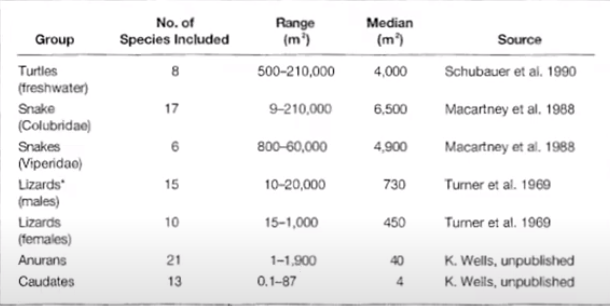
\

Home range %%varies%% between the %%sexes%%
- %%larger in males, smaller in females%%
- %%male%% home range size %%2x%% amount of female and is %%increasing%%
Defense (Territoriality)
- Usually %%very expensive%%, but where a required resource is insufficient for all individuals, %%defense may have evolutionary advantage%%
- Types
@@Territorial defense@@
- %%Relatively rare%%
- Mark territory with %%pheromones%%
- Accomplished through %%direct combat%%
@@Site defense@@
- %%More common%%
- Defense of %%point resource%%
- Basking sites, food, nesting
Introduction to Feeding & Food Habits
- Although some exceptions exist, amphibians and reptiles mostly feed on:
- @@Frogs & salamanders: insects@@
- @@Turtles: plans & animals (vertebrates & invertebrates)@@
- @@Squamates: animals (vertebrates & invertebrates)@@
Projectile Tongues
Commonly found in amphibians (Anurans)
\
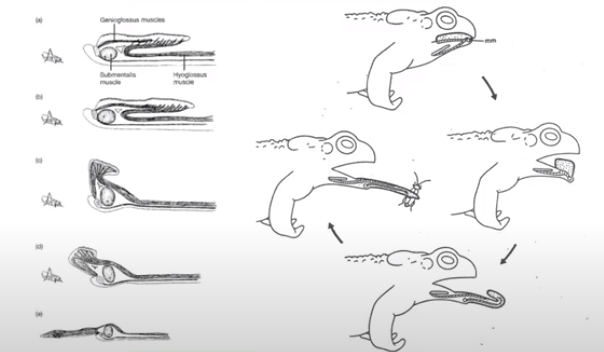
- On left:
- A: projection; mouth opening
- B: tongue flips forward
- C: tongue fully extended and turned upside down; dorsal surface of tongue tip encircles prey
- D: muscles contract and the retract tongue back inside
Plethodontidae Salamanders
\
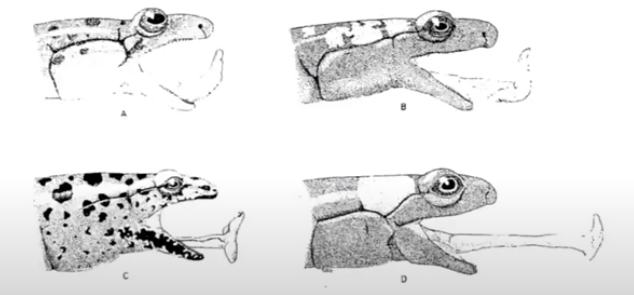
- A: minimal protrusion
- B: Modest protrusion
- C: free tongue and considerable protrusion
- D: free tongue and extreme protrusion
- In some salamander spp., length of tongue = half length of body
Squamates (Chameleons)
\
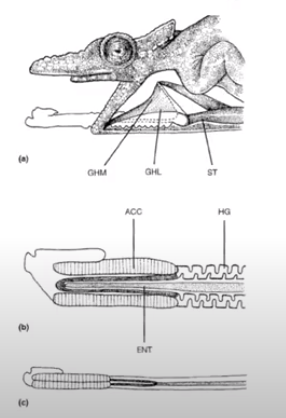
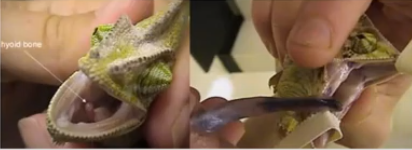
Digestive System
Digestive Glands
Oral cavity
- Amphibians: Intermaxillary gland
- Secretes a %%sticky%% compound that helps prey adhere to the tip of the tongue
- Found in both %%frogs & salamanders%%
- Reptiles: venom glands
- %%Modified salivary glands%%
- Very well-developed
- Used to %%subdue%% and %%digest%%
Opisthoglyph
\
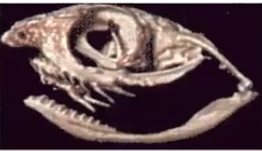
%%Rear-fanged%% snakes (back of maxilla)
Fangs not hollow
%%Weak%% venom
Due to location of fangs, %%snake must move prey to back of mouth%% before digestion
IN: Hognose Snake
Proteroglyph elapid snakes
\
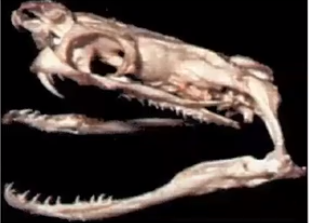
Forward-grooved snakes
%%Shortened%% maxillary bearing fangs with %%few teeth except for enlarged fangs%%
%%Fixed%% fangs with a %%hollow tube%% (like a needle/syringe)
Many species are some of the %%most toxic%% (%%neurotoxins%%)
Due to the %%shortened%% nature of its %%front teeth%%, it must %%hold on%% momentarily to inject the venom
Cobras & Brown Snakes (Australia)
Solenoglyph Viperid Snakes
- %%Most advanced venom delivery method system of any snake%%
- Each maxilla %%reduced%% to a nub supporting a %%single hollow fanged tooth%%
- Fangs can be as long as %%half the length of head%%
- Gaboon Viper: 2 in long fangs
- Folded against %%roof%% of mouth (hinged)
- Snake opens mouth %%180°%%
- %%Slightly less toxic%% than proteroglyph; a %%hemotoxin%%
Foraging Modes
Two general foraging methods
@@Sit-and-wait (ambush foraging)@@
- Very %%little%% investment in %%time & energy%% searching for prey
- %%Most%% energy spent in %%capturing & handling prey%%
- Users generally have %%very good eyesight or special organs (pits organ)%%
- Users rely on %%cryptic coloration%%
@@Active foraging (wide foraging)@@
- Predators are %%moving through the environment%% in search of prey
- Combination of %%visual & chemical cues%%
- %%Larger home range%%
- Higher %%ATR%%
Likely a %%continuum%% of foraging modes from these two extremes
\
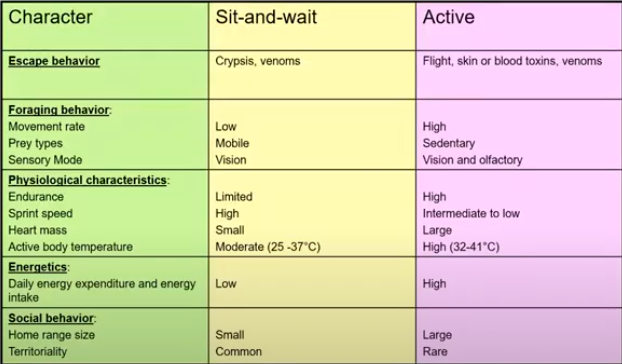
- Numerous %%ecological, behavioural, physiological, and life history%% parameters that correlate with foraging modes
Factors influencing foraging behaviour
External factors
- @@Prey availability@@
- @@Predation risk@@
- @@Societal interactions@@
- @@Habitat structure@@
Internal factors
@@How hungry is it?@@
@@Amount of learned experiences (coupled with age)@@
@@Sex and reproductive state@@
- Males may not forage since they are protecting their territory; females may forage more to produce enough eggs
@@Genetics@@
Phylogenetic factors
- @@Sensory limitations@@
- @@Morphological characteristics@@
- @@Physiological constraints@@
Prey Detection
Amphibians and reptiles can detect prey using different cues
@@Visual@@
Mostly used by %%sit-and-wait%% predators
Large, well-developed eyes
Discriminate prey based on %%shape and size%%
%%Binocular%% perception
- Can detect %%depth & distance%%
Most %%align%% heads or entire body axis with that of prey before attacking
@@Chemical@@
Olfaction
- Prey location identification by %%sniffing or rapid bugle pumping%% (frogs inflating their lower mouth)
- %%Long-distance%% detection system
- Main feeding sense of %%salamanders & lizards%%
Vomerolfaction (Jacob’s organ)
- %%Sensitive to high molecular weight compounds%%
- Transported to %%oral and nasal%% cavities by the %%snout or tongue%%
- %%Short-range%% detection system
- Main feeding sense in %%some salamanders & most snakes%%
- Snakes have %%bifurcated tongues%% (provides directionality of info)
- \
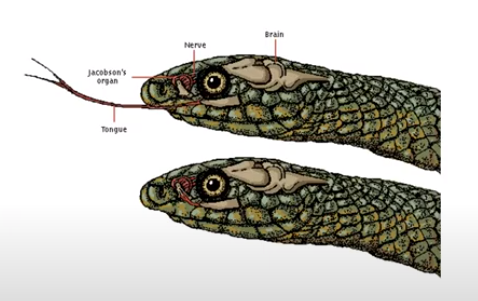
- Tongue flicks and picks up high molecular weight compounds
- Snake retracts tongue into set of grooves in upper snout in maxilla
- Forks transfer compounds into epithelial cells in Jacobson’s Organ
Taste
- Help %%distinguish%% food items from non-food items
@@Tactile@@
Relatively %%poorly understood%%
%%Mechanoreceptors%% in the skin (lateral line in aquatic amphibians)
In several spp., %%flaps of skin are highly innervated%% and also help in the tactile detection of prey
@@Thermal@@
%%Infrared light%% sensed by %%nerve endings%% in skin of head which are located %%inside pit organs%%
- Loreal pits in vipers
- Nasal/upper labial pits in pythons and boas
Pits open anteriorly (%%always face forward%%) and provide a %%binocular%%
Most effective for %%nocturnal spp.%% that feed on mammals & birds
Many spp. use some %%combination%% of these cues
Prey Capture & Ingestion
Prey Capture
- @@Biting and grasping@@
- Prey typically swallowed whole
- @@Constriction@@
- Common in boas & pythons
- @@Injected venoms@@
- Hemotoxins, neurotoxins
- @@Filter feeding@@
- Tadpoles: large buccopharyngeal cavities
- @@Suction feeding@@
- Prey is vacuumed into mouth
- @@Projectile tongues@@
Food Habits
Specific food habits depend on:
- @@Feeding adaptations of animal@@
- @@Size of animal and prey-capturing methods@@
- @@Habitat@@
- @@Relative abundance and size of prey available at time of feeding@@
Communication: Types
- Social behaviour
- An ^^interaction^^ with ^^one or more conspecifics^^ and occasionally with individuals of ^^different species^^ as well
- Communication
- ^^Transfer of information from a signaler to a receiver^^
- 4 basic types
- @@Visual@@
- Distinct colors/body movement
- @@Acoustic@@
- Vocalization/rubbing body parts together
- @@Chemical@@
- Odors
- Well-developed in salamanders, lizards, and some snakes
- @@Tactile@@
- Individual rubs/presses/hits a body part against another individual
- Advantages for communication
- %%Identify & locate mates%% in a complex environment
Communication: Salamanders
Chemical cues
- Salamanders use %%pheromones%%
- Hormones are produced by %%courtship glands%%
Tactical cues
- %%Mate location%% in Plethodontid salamanders aided by %%nose-tapping%%
- Also @@bite, slap, or rub@@ part of their bodies against each other
\
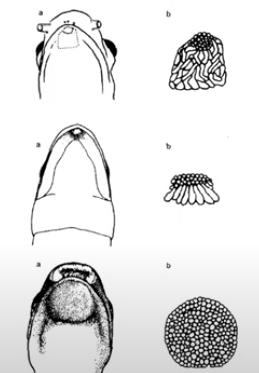
\
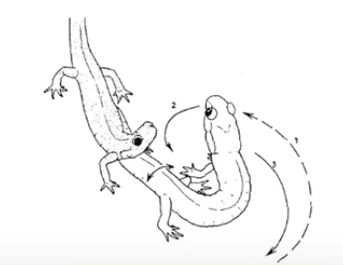
\
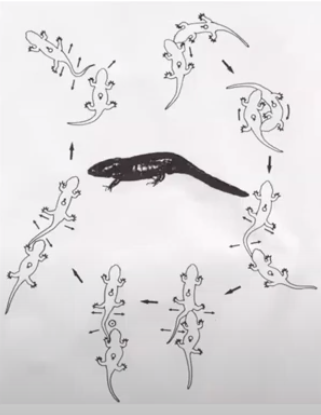
\
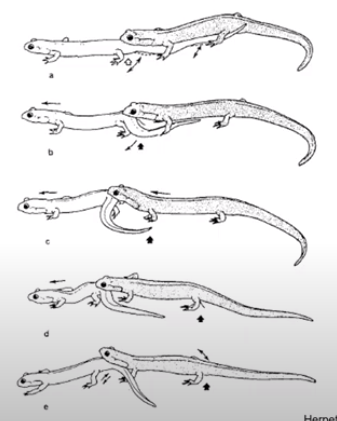
Communication: Frogs
Acoustic cues
- Very important
4 basic call categories
Advertisement
- Attract mates
- Deeper = better
Reciprocation
- Very rare
- Female calls in response to male
Release
- Males amplexing other males, so a release call is made by the one being amplexed
Distress
- Grasped by predator
Frogs can make vocalizations by passing air back and forth between lungs, vocal cords, and vocal sacs
\
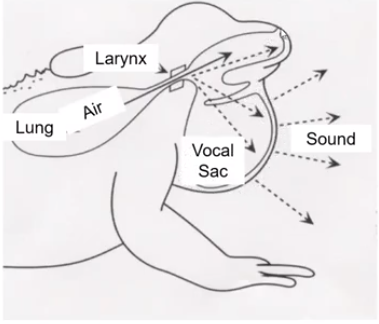
Visual cues
- %%Bright%% colorations
- Mostly in %%diurnal%% spp.
Communication: Turtles
- Visual cues
- Headbobs
- Tactile cues
- Ram, flip, trailing, biting, tickling
- Chemical cues
- Special glands on %%bridge of shells%%
- %%Cloacal secretions%% may also play a role
Communication: Lizards
Visual cues
Coloration of %%dewlaps,%% heads and sides of the body in males and %%bright coloration in females%%
\
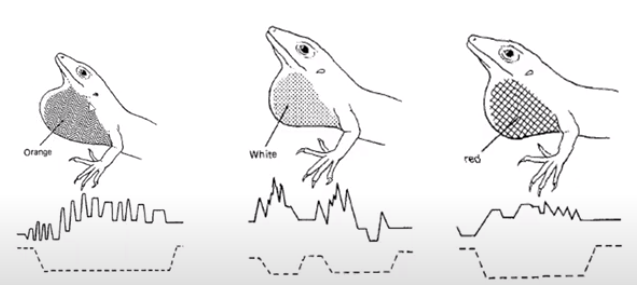
\
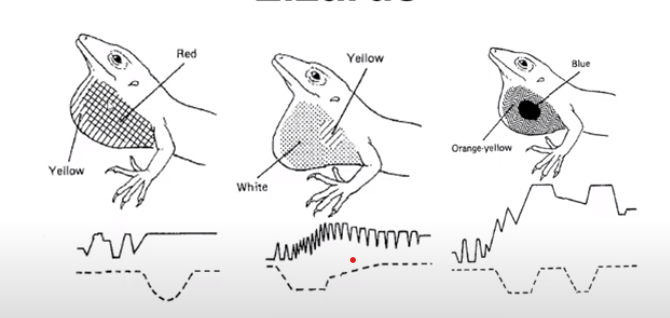
\
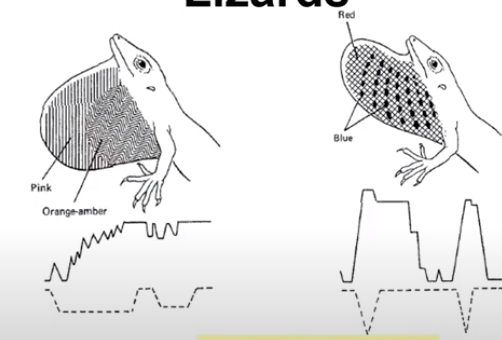
Chemical cues
- Pheromones (skinks)
Tactile cues
- Tongue flicking
- Neck & body scratching
Communication: Snakes
%%Tactile signals%% very important for snake courtship
3 different phases
Tactile phase
- A lot of %%chemosensory sampling of males%% to %%determine sex%% of the individual
Male %%chases%% female to copulate
Intromission & copulation
Group Behaviour: Competition
- Competition
- Interspecific
- Occasionally occurs %%among related spp%%.; frequently congregating spp. partition habitat %%temporally%% (especially during %%breeding)%%
- Different spp. in ephemeral ponds organize by spp. and by time of day
- Intraspecific
- Occasionally occurs when %%resources are limited;%% minimized in larval/juvenile forms
Group Behaviour: Cooperation
2 forms
@@Hibernation@@
- Different spp. of snakes hibernating together to reduce evaporative loss during winter
@@Breeding Aggregations@@
- Male frogs taking turns to call a female (reduces intraspecific competition)
Introduction: Predation
- The greatest cause of mortality in natural amphibian and reptile populations
- Any traits that reduce predation are under strong selection pressure
- Most amphibs and reptiles employ several different mechanisms
Predator Avoidance
Escaping detection
- Not being present when a predator i searching for prey
Crypsis and immobility
Resemble a random sample of certain aspects of the enviro
Polymorphic coloration
- individuals in a species have different colors and patterns
Aposematic coloration
- Bright coloration in animals that produce noxious or lethal chemicals from skin glands
Postural warning
- Assuming several defensive postures to “scare” predators
- Red-eyed tree frog
Mimicry
Batesian
- When a nontoxic species mimics a toxic or protected one
Mullerian
- When one or more potentially dangerous species resemble each other and each is both the model and the mimic
Northern coral snake being imitated by the scarlet snake
- “Red on black, friend of Jack. Red on yellow, kill a fellow.”
Escaping approach
- Running away and hiding
- Active foragers
Escaping Predators
Skin, armor, and spines
- Structures can protect an animal from a predator attack
- Not very developed in amphibs
Chemical defense
- Glands producing irritating, distasteful or lethal compounds
- Very developed in amphibs
Death feigning
- Eastern hognose snake
Tail displays and autotomy
- Tails separating from body
Schooling
- Commonly seen in tadpoles
- Group can appear as one big organism instead of individual tadpoles
What is a disease?
- “Any deviation from, or impairement of the normal structure or function of any part, organ, or system of the living animal or plant body”
- Clinical signs may be morphological, physiological, or behavioural
- Morbidity, mortality, reduced growth, malnutrition, developmental, mental, activity level, appearance, etc.
Major types of diseases
- Infectious
- Contagious v. non-contagious
- Genetic
- Nutritional & physiological
- Scurvy
- Toxicological
- Biotic v. non-biotic
- Biotic: toxic algal blooms
- Traumatic
- Losing a limb
- Mental Illness
- Combinations
Agents of infectious disease
Microparasites
Bacteria, viruses, protists, fungi
Infected v. uninfected
- Really the most important thing
Reproduce very quickly inside host
Macroparasites
Helminths (trematodes, nematodes, cestodes, acanthocephalans)
Arthropods (ticks, copepods, lice, insects, mites, fleas, etc.) & leaches
Intensity-dependent pathology
- The more macroparasites you have, the greater the impact they have on you
Modes of transmission
- Direct
- Horizontal
- Sneezing, coughing, etc.
- Vertical
- Parent to offspring
- Single host
- Multi-host
- Indirect
- Complex life cycle
- Needs multiple hosts
- Vector-borne
- All parasites want to maximize transmission
Parasites and extinction
- Parasites rarely drive their hosts to extinction
- Transmission limited at low population sizes
- Similar to predator-prey cycles
- Several factors can help drive disease-induced extinction
- Small populations (inbreeding, stochasticity)
- Frequency-dependent transmission (STDs)
- Multiple host species
- If parasite is a generalist
- Environmental reservoirs or persistence
Amphibian parasites
- Host to a diversity of parasites
- Viruses
- bacteria
- Fungi
- Water mold
- Trematodes
- Most are relatively benign and the individual can clear the infection or live with it
3 Parasites of Conservation Concern
- Batrachochytrium dendrobatidis (fungus)
- Ranaviruses (virus)
- Ribeiroia ondatrae (trematode)
- Linked to mortality events, severe pathology (malformations), or extinctions
- Relatively new to science (1996)
- Appear to be increasing in prevalence in amphib populations either locally or globally
Chytrid fungus
- Batrachochytrium dendrobatidis (Bd)
- Non-hyphal parasitic fungus (aquatic)
- Only chytrid species pathogenic to vertebrates
- Attacks keratinized tissue
- Larvae: only the mouthparts have keratin
- Adults: Keratin found throughout skin
- Life cycle
- Zoospores
- Floating around in water
- Once contact is made, forms a cyst right under skin
- Cyst continues to grow and eventually pops like a pimple
- Goes on to infect more skin
Field signs of Bd infection
- Lethargy and paralysis
- Sloughing of skin and skin lesions
- Time to death highly variable (18-48 days)
- Infected individuals may appear healthy
- Some species live with infection
- May serve as reservoirs for other spp. to get infected from
- Loss of pigmentation in mouth parts of larvae
Cause of Bd mortality
- Impaired osmoregulation (suspected primary cause)
- Decreased water uptake and ion exchange (sloughed skin)
- Altered electrolyte/solute levels (decrease in calcium interferes with muscle activity)
- Lethargy and paralysis
- Impaired cutaneous respiration
Why is the fungus emerging?
2 hypotheses
Native pathogen
Increasing in prevalence due to some environmental change (climate change)
Increased amphib stress
Novel introduction
Pathogen somehow got introduced to a new area
Encountering hosts that have never evolved to deal with this pathogen
Africa → Central America, Australia, US
\
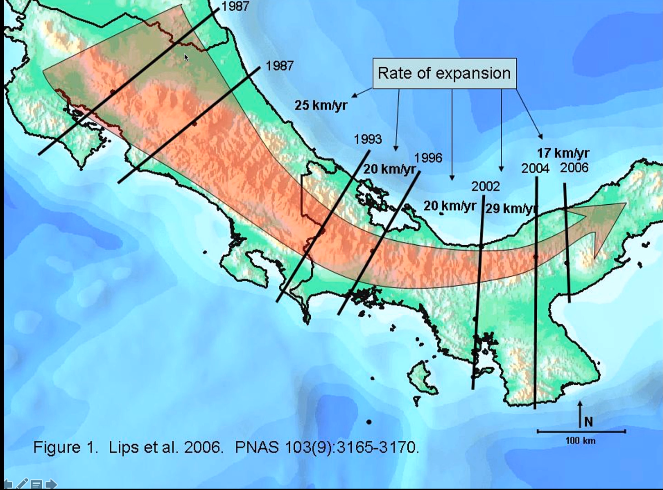
\
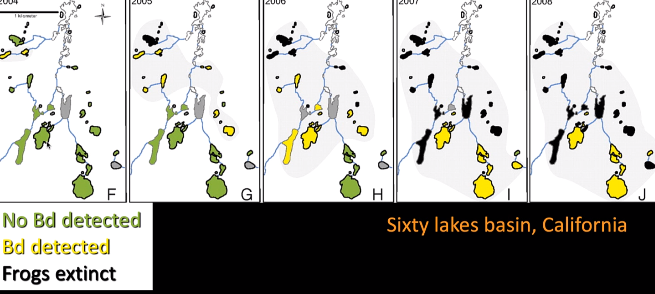
Bd Distribution
- Present in most well sampled areas
- While detected globally, the outcome of infection varies widely among regions
- \
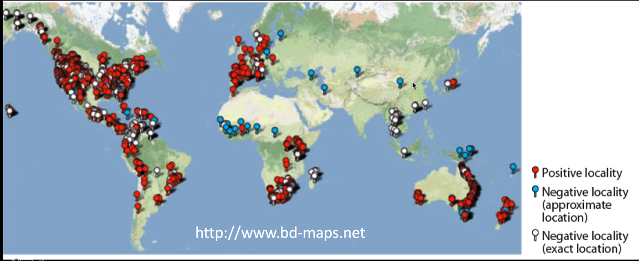
Bd: Patterns of susceptibility
- Species vary widely in susceptibility to infection and disease outcomes
- Extinctions have occurred
- Frogs appear to be more susceptible than salamanders
- Use of aquatic habitats increases chances of exposure
- Some species act as reservoirs
Amphibian ranaviruses
- Infect ectothermic vertebrates (herps and fish)
- 6 total spp.
- 3 spp. are known to infect herps (>15 isolates)
- All 3 ranaviruses linked to amphibian die-offs
- Ambystoma tigrinum virus (ATV)
- Bohle iridovirus (BIV)
- Frog virus 3 (FV3)
- Characteristics
- dsDNA (double-stranded DNA)
- 3x smaller than bacteria
- Icosahedral shape (20 sides)
- Paracrystalline arrays
Organ Destruction
3 primary organs: liver, spleen, and kidney
- \
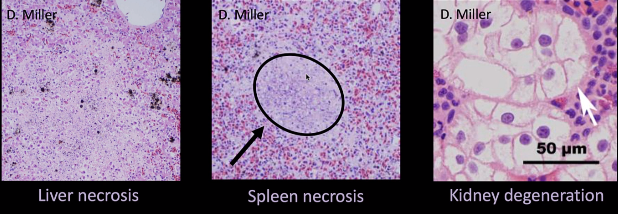
- \
Cell death occurs within 6-9 hrs
\
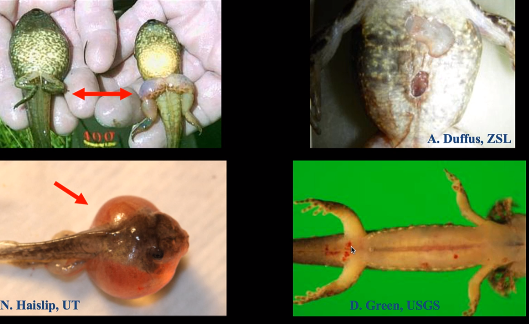
\
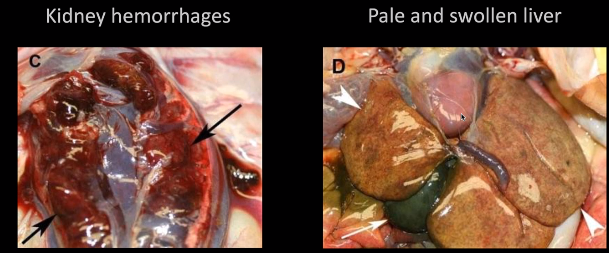
Fast progression
- 1-3 days signs, 3-7 days mortality
Persistence and transmission
- Concerns typically evaporate along with bodies of water
- Becomes a concern again when ponds form and adults congregate to breed
- No vertical transmission; horizontal instead
Ranavirus: Patterns of susceptibility
- Species vary widely in susceptibility to infection and disease outcomes
- Population declines have occurred
- FV3 → frogs; ATV → salamanders
- Ranids highly susceptible to FV3
- Wood frogs, tree frogs, etc.
- Fast developing larvae = poorer immune functions
- Some species may act as reservoirs
Parasite Infection → Deformed Frogs (Trematoda)
- Ribeiroia ondatrae (Trematoda)
- Parasitic fluke (Plathyelminthes)
- Targets limb tissue
- \
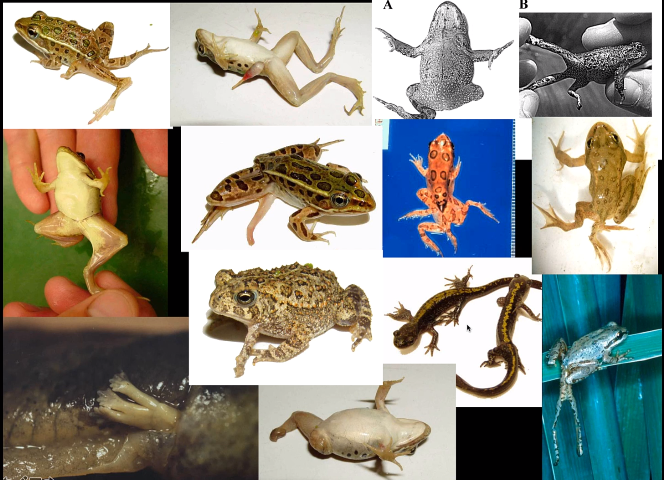
Cycle of deformity
aquatic snails
- Picked up from infected bird feces
- Rediae, cercariae
- Asexual reproduction
Amphibs
- Metacercariae
Waterfowl
- Adults
- Sexual reproduction
- Extra legs serve to make predation easier (to complete parasite life cycle)
- \
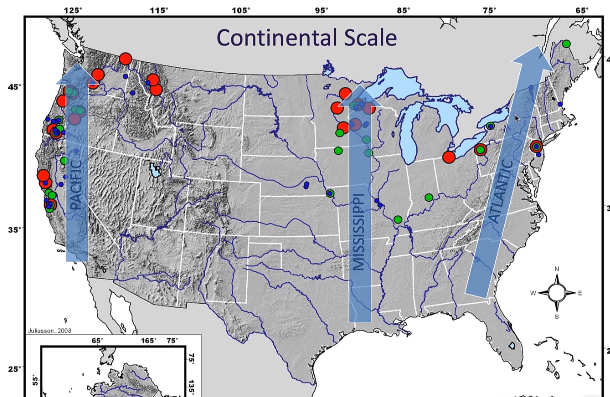
Human Influences
- Factors that influence snail abundance should be linked to parasite load in amphibs and malformations
- Eutrophication
- Ecosystem response to the addition of artificial or natural substances, such as nitrates and phosphates
- Bottom-up effect
- Algal (plant) population growth increases due to the addition of fertilizer
- Higher snail abundance → more infected snails → More cercariae per infected snail → more infection in amphibians
Conservation of Amphibians and Reptiles
General Principles
- Biodiversity crisis
- Loss and reduction in diversity at all levels (genetics → ecosystems)
- Primarily focus on single spp. conservation due to lack of resources for anything much bigger (e.g. habitat/environment)
- Extinction
- Rate has greatly exceeded the “normal” historical rates
- Could lead to cascading extinction events
- The loss of one spp. causes the loss of multiple
Current trend: Amphibians
- World-wide amphibian declines
- 1,260 of 6,000 spp. (21%) are endangered
- 1,856 of 6,000 spp. (32%) are threatened
- 2,469 spp. are in decline (43%)
Current trend: Reptiles
- World-wide reptile declines
- Reptiles not completely assessed (mostly Chelonians)
- Best estimate 833 of 6,500 spp. (13%) endangered
- Turtles and tortoises well reviewed
- 108 of 257 spp. (42%) threatened
Human Impacts
- Humans have modified the environment everywhere through
- Habitat modification, fragmentation, loss
- Most visible human mediated environmental change
- Agriculture
- Urban growth and paving
- Overall consequences:
- Habitat alteration and fragmentation (dispersal barriers)
- Increased mortality due to road kills
- Loss of breeding, foraging, & over-winter areas
- Population declines and extinction in some cases
- Road mortality
- Skewed sex ratios in turtle populations
- Predicted higher sex ratio skew in high road density
- Road mortality of females on nesting migrations
- Historical male-biased sex ratio?
- Proportion of males increased linearly
- Synchronized with increase in paced roads
- Indiana Road Mortality
- Surveyed Lindberg Road for 1.5 years
- Vertebrate road mortality N=8,176
- Herps represented n=8, 016
- Miles of paved roads in Indiana ~93,600
- Harvest
- Mostly for commercial exploitation
- Consumption (food and folk medicines)
- Luxury trade (leathers, jewelry)
- Pet Trade
- Focused on a relatively few spp. in any locality (developing countries)
- Sustainable harvest by small communities can also decimate populations
- Examples
- Consumption: larger, long-lived spp. (Chelonians, specifically the Apalone and also Varanus lizards)
- 1990’s Europe imported 6,000 tons of frog legs/year
- India and Indonesia exported 50 million frogs/year
- Banned exports in 1987 and 1992
- Depleted natural insecticide from paddy fields
- Luxury Trade: American Caimans → leather
- Pet Trade: Box turtle declines in 16 states (~30,000 box turtles since 1995)
- High prices for rare and brightly colored spp.
- Introduction of exotic spp.
- Exotic spp.: Introduced/non-native
- Black and Norway Rats → great impact on islands (lizards, tuataras, tortoises)
- Domestic cats → widespread damage in suburban and rural areas
- Herbivores (goats, rabbits) → change vegetation
- American Bullfrog
- Game spp. (frog legs)
- large
- High mobility
- Live 7-9 years
- Huge reproductive potential
- Generalized feeding habits
- Snakes, worms, crustaceans, insects--anything that fits in its mouth
- California: bullfrogs reduced leopard frog survivorship by 33%
- Arizona: bullfrogs responsible for leopard frog declines (79 out of 80 sites now extirpated; 79 sites completely devoid of leopard frogs)
- Management Tools
- Establishment of refuges and corridors
- Main objective: prevent extinction
- Key issue: How much area to preserve?
- Location, size, and shape of refuges and corridors is dependent on:
- Whether spp., communities, and/or ecosystems are targeted for conservation
- Natural history characteristics of the above
- Minimum Viable Population (MVP)
- Minimum area required for a population or spp. to survive
- Studies of terrestrial buffer zones with freshwater turtles
- Savannah River Ecology Laboratory (SREL)
- Do protected acreage of wetlands protect areas critical for nesting and hibernating?
- No, they do not
- Management of animals in captivity
- Animals can be managed in captivity for:
- Short periods (temporary)
- “Headstart” (from hatchling to 6-12 months)
- Hatcheries (egg incubation)
- Long periods
- Duration of an individual’s life
- Sometimes several generations
- Crocodilian farming and ranching
- Reintroductions of wild spp.
- Intentional release of individuals to establish or enlarge the population of a target spp.
- Target spp. usually threatened or endangered
- Some problems
- Generally very few of the animals that are re-introduced survive
- Introduction of diseases into healthy populations
- Outbreeding depression
- Pollution
- Diseases
The Process of Amphibian Conservation: The Eastern Hellbender model
- Phase 1
- Health & Genetics
- Sampled 10 states, 70 rivers, and 1200 samples
- Blood draws for health screens and DNA samples
- Two large clusters
- Ohio River Drainage (Indiana, Ohio, West Virginia, Pennsylvania)
- Tennessee River Drainage (Georgia, Tennessee, North Carolina, Virginia)
- i.e. Hellbenders in Indiana are genetically similar to those in Ohio
- Sampling
- Population Assessment
- Understand how many Hellbenders you have
- 88 in Dr. Williams’ case
- Density
- 0.06/100m^2
- Spatial Ecology
- Health (blood work, sperm, weight class, etc.)
- Habitat & Home Ranges (radio transmitters and radio telemetry)
- Hellbenders are very rare; distributed randomly across the landscape with very little interaction between other Hellbenders
- Survival
- Annual Hellbender survival if no action is taken: 0.804
- Phase 2
- Population Manipulation
- Recovery Strategies
- Population Viability Analyses
- Captive rearing and release
- Translocations
- Intra-river translocation
- 10 native adults & 10 translocated adults
- Captive relreases
- 10 native adults
- 10 captive juveniles
- Spatial Ecology
- Home range size nearly cut in half (2212 v. 1348 m^2)
- Extensive HR overlap among individuals
- Two egg clutches
- Post-translocation
- No impact on annual survivorship of adults (80% v. 78%)
- 50% juvenile survivrship had exceeded 30% threshold to prevent extinction :D
- Outreach & Education
- Mail survey
- 1378 Distributed
- 281 to Riparian Landowners
- 541 Completed (41%)
- In-person survey
- 242 surveys conducted
- 6 access sites
- Focus
- Awareness, attitudes, behaviour
- Approach
- “3D Model” of O & E
- Develop the portal
- Design the content
- Deliver the programs
- Evaluate impact
- HelpTheHellbender.org
- Impact
- Nationally
- 25 organizations (6 state/fed agencies, 8 zoos, 11 universities)
- 63% monthly
- 82% follow
- 81% recommend to others
- Population Modeling
- 2011-2012, 33 Hellbenders
- 2018, 5 male Hellbenders
- Must focus on juveniles
- Increase juvenile survivorship → expected local extinction in 26 years goes up to 35
- 30-50% increase → almost completely reverse the probability of Hellbender extinction
- Problems with heavy predation → low juvenile survivorship
- Phase 3
- Restoration
- Captivity can deprive animals of experiences/natural stimuli
- Predator cues
- Stochastic events
- Refuge
- Live prey
- Habitat variability
- Advancing Headstarting
- Introduce captive, juvenile Hellbenders to natural conditions to better prepare them for the wild
- Investigate the effects of:
- Moving water
- Predator cues
- Microbiome
- 90% survivorship in 200 days, then averages around 75%
- Phase 4
- Providing farmers federal grant money to implement conservation practices in watersheds
The Many Components of Conservation Biology
- Research
- Education/Outreach
- Management
- Captive breeding
- Partnerships
- A collaboration with many interested bodies
- Semiannual meetings
- Action Teams
- Habitat
- Outreach & Education
- Captive Rearing/Breeding
- Animal Health